
OWNER'S MANUAL
SEA/RS
SEWING MACHINE
MODEL 385. 1764180

OWNER'S MANUAL
SEA/RS
SEWING MACHINE
MODEL 385. 1764180

SEARS, ROEBUCK AND CO.
Dear Cuatomer:
You have just invested in a very fine zigzag sewing machine. Before using your new Kenmore machine, please pause for a moment and carefully read this booklet which contains instructions on how to operate and care for your machine.
Specific instructions are given on threading, tension adjustments, cleaning, oiling, etc. This will help you obtain the best sewing results and avoid unnecessary service expense for conditions beyond our control.
Advice on the operation and care of your machine is always available at your nearest Sears Retail Store. Please remember, if you have questions about your machine or need parts and service, always mention the model number and serial number when you inquire.
Kenmore Sewing Machine
Record in space provided below the model number and aerial number of this appliance. The model number and serial number are located on the nomenclature plate, as identified on Page 3 of this booklet.
Model No. 385.Serial No.
Retain these numbers for future reference.
THIS MODEL IS A CENTER NEEDLE, LOW BAR SEWING MACHINE.
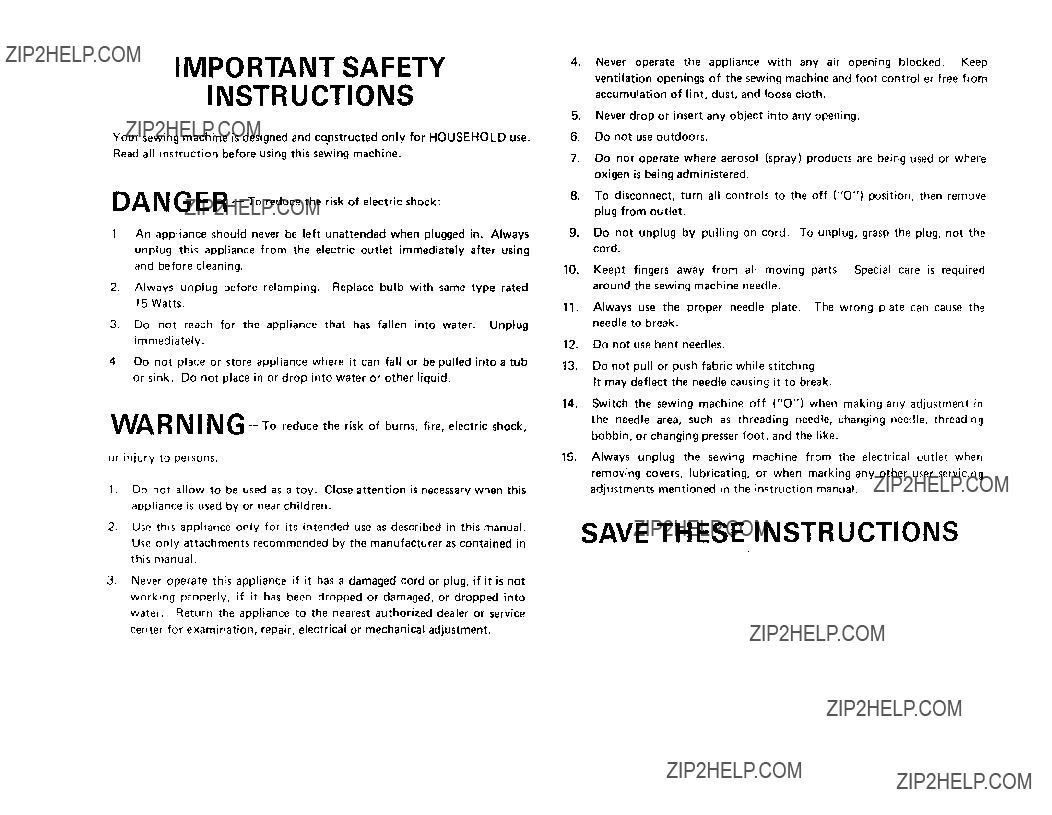
IMPORTANT SAFETY
INSTRUCTIONS
Your sewing machine is designed and constructed only for HOUSEHOLD use. Read all instruction before using this sewing machine.
DAN G ER- To reduce the risk of electric shock:
1An appliance should never be left unattended when plugged in. Always unplug this appliance from the electric outlet immediately after using and before cleaning.
2. Always unplug before relamping. Replace bulb with same type rated
15Watts.
3.Do not reach for the appliance that has fallen into water. Unplug immediately,
4.Do not place or store appliance where it can fall or be pulled into a tub or sink, Do not place in or drop into water or other liquid.
WAR N ING- To reduce the risk of burns, fire, electric shock,
or injury to persons.
1.Do not allow to be used as a toy. Close attention is necessary when this appliance is used by or near children.
2Use this appliance only for its intended use as described in this manual.
Use only attachments recommended by the manufacturer as contained in this manual.
3.Never operate this appliance if it has a damaged cord or plug, if it is not working properly, if it has been dropped or damaged, or dropped into water, Return the appliance to the nearest authorized dealer or service center for examination, repair, electrical or mechanical adjustment,
S, Never drop or insert any object into any opening.
6.Do not use outdoors.
7.Do not operate where aerosol (spray) products are being used or where oxigen is being administered.
8, To disconnect, turn all controls to the off ("O") position, then remove plug from outlet.
9.Do not unplug by pulling on cord. To unplug, grasp the plug, not the cord.
10.Keept fingers away from all moving parts. Special care is required
around the sewing machine needle.
11.Always use the proper needle plate. The wrong plate can cause the needle to break.
12.Do not use bent needles.
13.Do not pull or push fabric while stitching.
It may deflect the needle causing it to break.
14.Switch the sewing machine off ("O") when making any adjustment in the needle area, such as threading needle, changing needle, threading bobbin, or changing presser foot, and the like.
15.Always unplug the sewing machine from the electrical outlet when removing covers, lubricating, or when marking any other user servicing adjustments mentioned in the instruction manual.
SAVE THESE INSTRUCTIONS
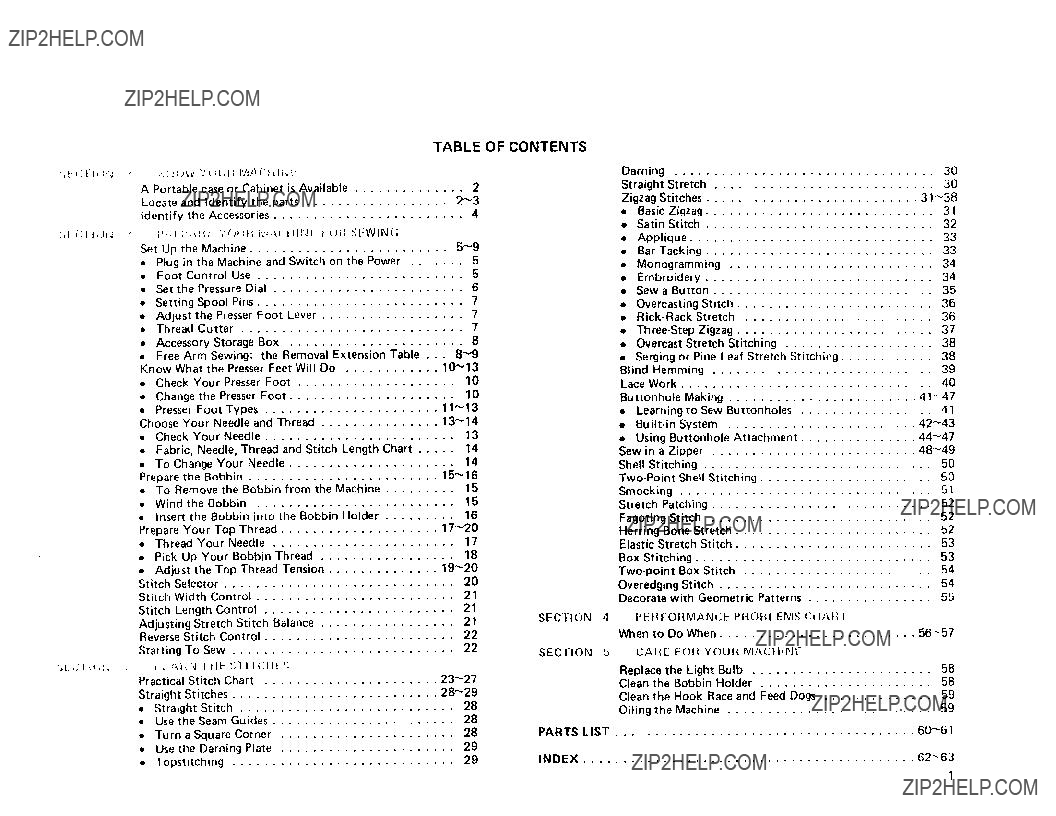
TABLE OF CONTENTS
???Free Arm Sewing: the Removal Extension Table . . . 8"9
1

SECTION 1. KNOW YOUR MACHINE
A Portable Case or Cabinet is Available
A full line of sewing cabinets is available at your nearest Sears retail store or through our general catalog.
Another option . . . buy a Carrying Case . . . then
your Kenmore goes anywhere, can be stored any- where.
Locate and Identify the Parts
Thread Spool Pins
Upper Thread Guide
Take up Lever
Top Thread Tension
Control
Face Cover Plate
Thread Cutter
Needle Plate
Extension Table
(Accessory storage box )

Arm Cover Plate
Hand Wheel
Push Pull Clutch
Stitch Sel_',"t or
Stretch Stitch Adluster
??{qht and Power Switch
P)u_ Ctlnnector
SECT ON 1. KNOW YOUR MACHINE
Carrying Handle
Thread Guide
..
Needle Clamp
Presser Foot
Thumb Screw
Presser Foot
Snap on Button
Presser Foot Lever
Foot Control
Nomenclature Plate

Identify the AccesSories
But tonhole plateguide
Buttonhole templates/'
Lint brush
Spool pin felt
loot
Satin stitch
Buttonhole foot

\-
Sewin_ liqht
Power switch
Plug
connector
Machine plug
SAFETY FEATURE:
To increase speed, gently press down with
the ball of your foot.
NOTE: Before inserting the plug into your machine, be sure the power switch is OFF.
t.Check your outlet to be sure it is a 110 to 120 Volt AC outlet,
2.Insert the machine plug into the
3.Insert the power supply plug into the outlet.
reverse the plug. If it still does not fit, contact a qualified electrician to install the proper outlet. Do not modify the plug in any way."
"Foot Controller Model
385.1778x x x, 385.1684x x x, 38&1584x x x, 385.1664 x x x, 385.1754 x x x, 385.17526x x x, 385.1764x x x, 385.1884x x x, 385.17928 x x x, 385.17924 x x x, 385.18836 x x x,
385.17922x x x, 385.16816x x x, 385.17822x x x, 385.17828 x x x, 385.18830 x x x and

Set Up the Machine (Continued)
Set the Pressure Dial
The pressure control dial is located inside the face cover plate.
Set the dial aligning the setting mark on the dial with the groove as follows,
NOTE: The pressure dial should be reset at 3 after changing pressure, so the machine is ready for most normal sewing the next time you use
it.

The spool pins are used for holding the spools of thread in order to feed thread to the machine.
To use, pull up the spool pins. Place the spool felt on the pins. Push down for storage.
SECTION ,2.
???Adjust the Presser Foot Lever
The Presser Foot Lever raises and lowers your presser foot.
You can raise it about 1/4" higher than the normal up position for easy removal of the presser foot or to help you place heavy fabrics under the presser foot
PREPARE YOUR MACHINE FOR SEWING
Thread Cutter
You don't need a pair of scissors to cut the thread after you finish sewing. Just use the handy thread cutter.
The threads are cut the proper length for starting the nextseam.
7
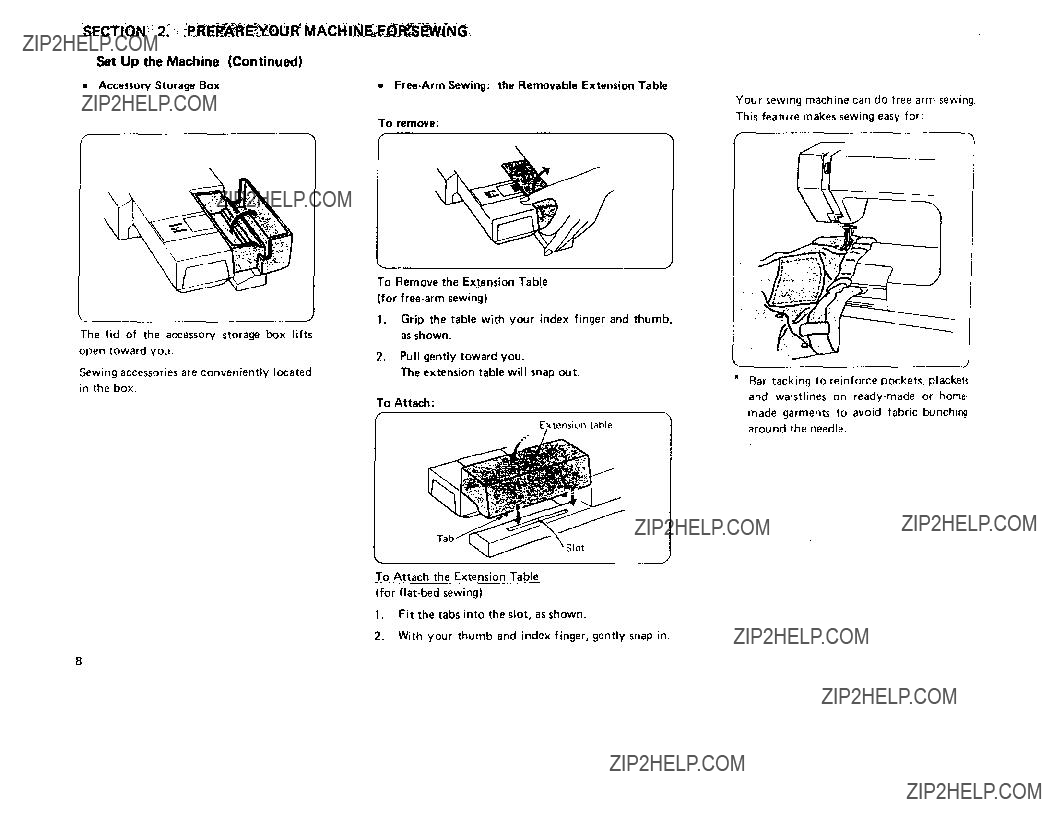
SECTION 2: _,.'_RI_i=_',/_I_QIJR!MACH|I_I_EJ_'J_J'NG_
Set Up the Machine (Continued)
Your sewing machine can do free arm sewing.
This feature makes sewing easy for:
The lid of the accessory storage box lifts open toward you.
Sewing accessories are conveniently located in the box.
To Remove the Extension Table
(for
1.Grip the table with your index finger and thumb, as shown.
2.Pull gently toward you.
The extension table will snap out.
To Attach:
Extension table
Slot
To Attach the Extension Table
(for
1.Fit the tabs into the slot, as shown.
2.With your thumb and index finger, gently snap in.
???Bar tacking to reinforce pockets, plackets and waistlines on
8
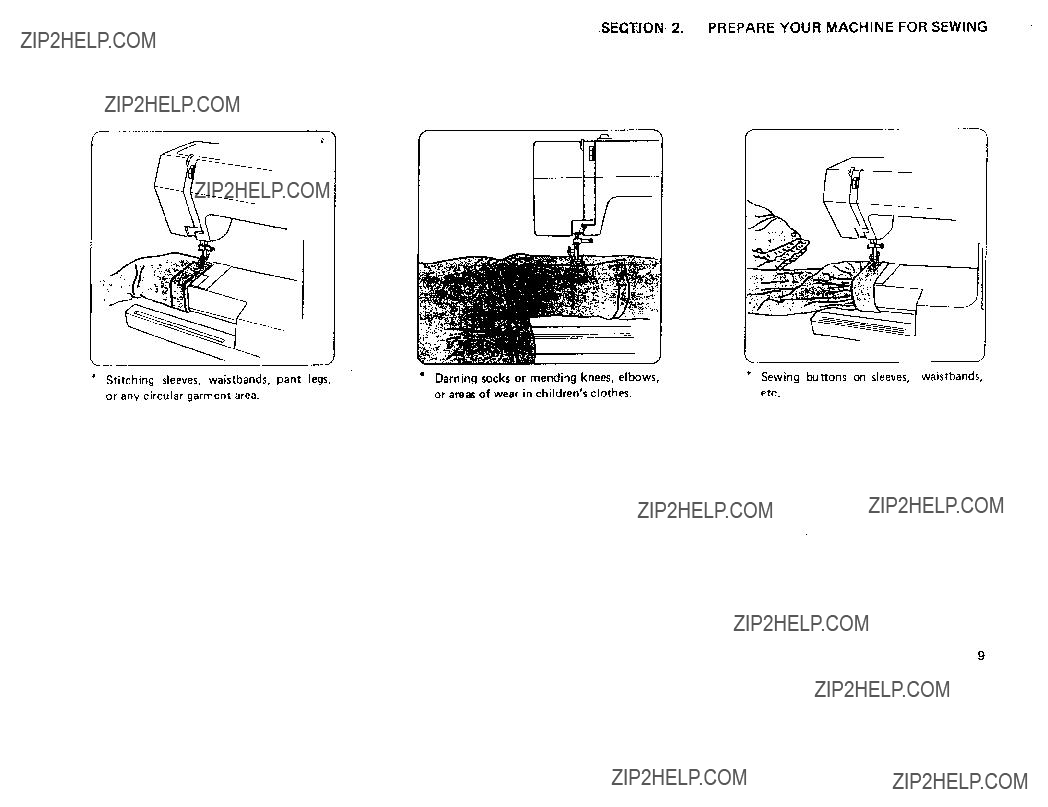
SECTJON 2. PREPARE YOUR MACHINE FOR SEWING

SECTION 2. PREPARE YOUR MACHINE FOR SEWING
Know What the Presser Feet Will Do
???Check Your Presser Foot
Tile Presser feet are an important feature of this machine. You need to know what each foot does in order to use thefn effectively.
Your presser foot is held in place by a Foot Holder. Each presser foot merely snaps on the foot holder, which is seldom removed.
If vou need to remove or attach the foot holder, here is what you do:
???Change the Presser Foot
Use the correct presser foot for the stitch you wish to sew. Consult the
Stitch Pattern Chart and the detailed directions for sewing with the various presser feet.
To Snap Off:
To Remove:
Turn the screw toward the back of the machine. Use the large screw driver.
To Attach:
1.Match the hole in the foot holder with the threaded hole in the presser bar.
2.Fit the foot holder screw into the hole.
3.Tighten the screw by turning it toward you.
1.Raise the needle bar to its highest position by turning the hand wheel . toward you.
2.Raise the presser foot.
3.Press the
10

To Snap On
SECTION 2. PREPARE YOUR MACHINE FOR SEWING
???Presser Foot Types
Pin
To Snap On the Presser Foot:
1.Ptace the presser foot so the hori- zontal pin on the foot lies just under the groove of the foot holder.
2.Lower the presser foot holder to lock the presser foot in place.
NOTE : If you do not hear the presser foot snap in place, press down on the presser foot holder firmly until you hear the snap.
Use this foot for both straight and zigzag stitching.
Uses: Zigzag stitching (see page 31),
Bar tacking (see page 33), Button sewing (see page 35),
(see page 5_00), Smocking (see page 51),
Stretch patching (see page 51),
Fagoting (see page 52),
Herring bone stretch (see page 52), Elastic stretch (see page 53),
Box stitching (see page 53),
Overedging stitch (see page 54).
Use this foot exclusively for straight stitching using center needle position only.
Uses: Straight stitching (see page 28),
Topstitching (see page 29),
Straight stretch (see page 30).
11
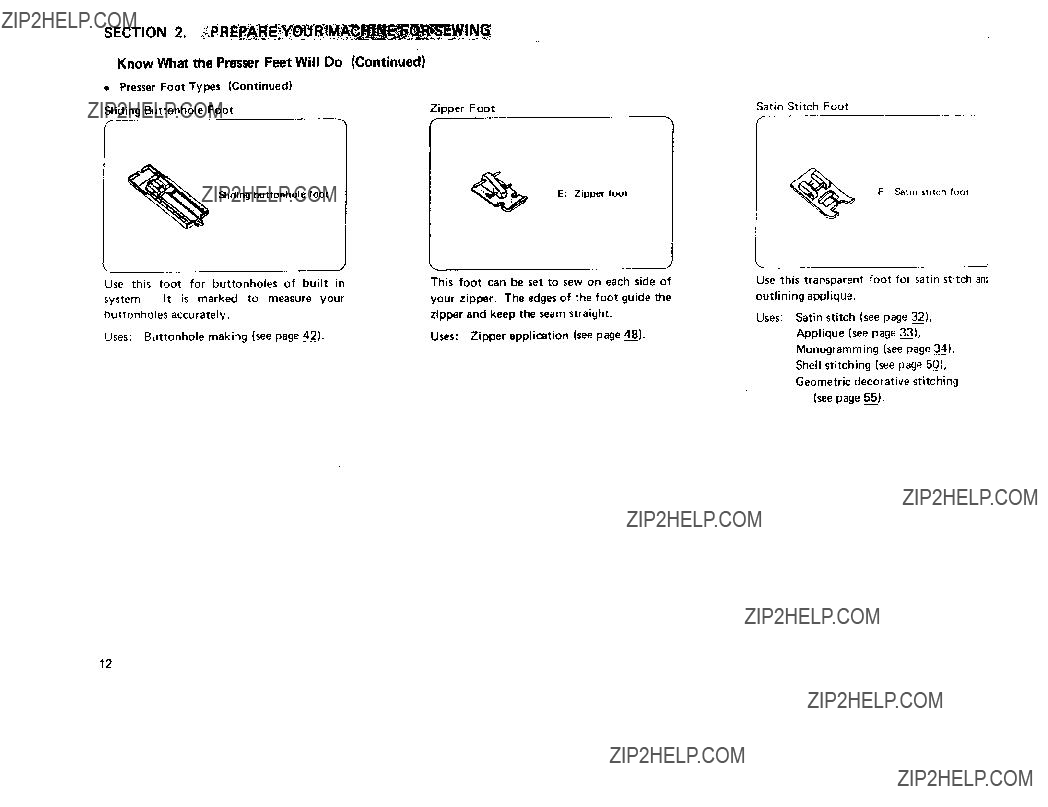
SECTION 2. :_,I_RE'_.,__='__WIN_
Know What the Presser Feet Will Do (Continued)
???Presser Foot Types (Continued)
E; Zipper foot
S_idlngbuttonholefoot
Satin Stitch Foot
F: Satin stitch foot
Use this transparent foot for satin stitch ant
outlining applique.
Uses: Satin stitch (see page _3_2), Applique (see page 33),
Monogramming (see page 34),
Shell stitching (see page 50),
Geometric decorative stitching
(see page 55),
12
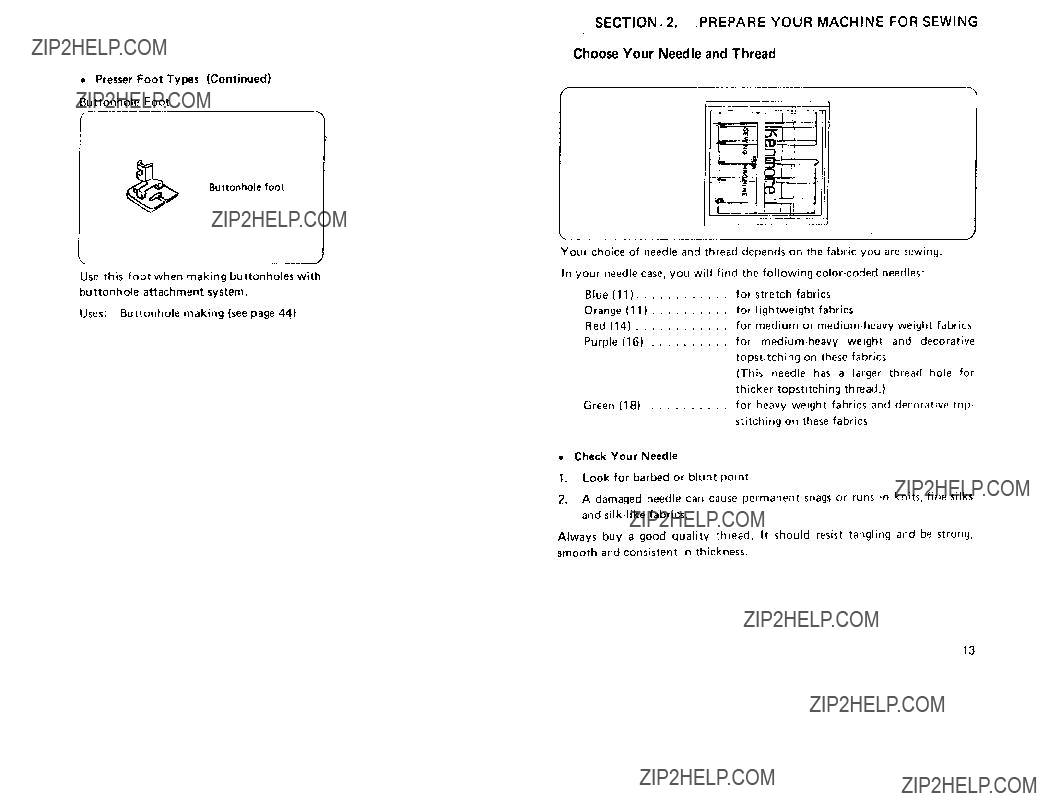
???Presser Foot Types (Continued)
Buttonhole Foot
Buttonhole foot
Use this foot when making buttonholes with buttonhole attachment system.
Uses: Buttonhole making (see page44)
SECT ONe2 PREPARE YOUR MACHINE FOR SEWING
Choose Your Needle and Thread
???Check Your Needle
I. Look for barbed or blunt point.
2.A damaged needle can cause permanent snags or runs in knits, fi_e silks and
Always buy a good quality thread. It should resist tangling and be strong, smooth and consistent in thickness.
13

Fabric, Needle, Thread and
FABRIC
LpghtweJgh!
Babste Oimily. Chiffon.
Silks, Fine Lace, Organza,
Crppe, Taffexa, Voile,
Organdy
Medrum Weight :
Colton, Cotton Blends.
Percale, Gingham.
Shantung, Pique,
SPer_ucker, Satin, Knits,
Vinyl Su_tings, Linen,
Wool Crepe_ Leather
Medium Heavy Weight:
Corduroy. Denim, Wool,
Sailcloth, Woo! Flannel.
Gaba,dine, VeJve_s,
Lealher
RPavy We;ghl
Coatings, U_holstery
Cotlon Duck. Heavy
Tw_Us, Canvas
Decorative top stitchln 9
On all types of fabric
Stretch Fabric:
Polves er Double Kn is,
NV!on Tr co , Jer_;ey
SlIPtCh Terry, Spandex,
Clre Tricot
E_y O U _MA_II_m_Q.'IFL_ EWJ._.
Stitch Length Chert
RECOMMENDED
STITCH LENGTH
SETTING
2
(12 stitches per
inch)
3
(8 stitches per
inch)
per inch)
To Change Your Needle
r I,_I
S_dl, :l';va V f KL_rII
/_}LJ
1.Loosen the needle clamp screw by turningl{ toward you.
2.Remove the needle by pulling it downward.
3.Insert the new needle into the needle clamp with the flat side away from you.
4.Push the needle up as far as it will go.
5.Tighten the needle clamp screw firmly with the large screwdriver from your accessory storRt box.
14
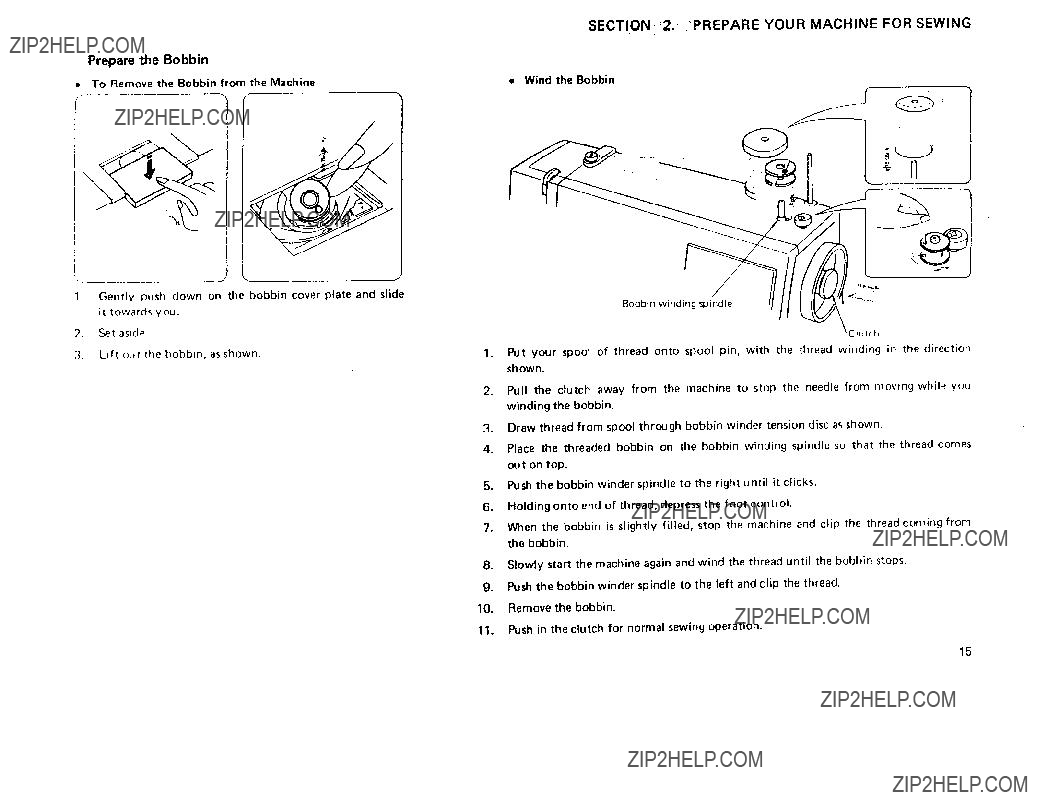
Prepare the Bobbin
???To Remove the Bobbin from the Machine
1Gently push down on the bobbin cover plate and slide it towards you.
2.Set aside.
3.Lift c)ut the bobbin, as shown.
SECTION !2; _PREPARE YOUR MACHINE FOR SEWING
???Wind the Bobbin
Bobbin windingspindle
1.Put your spool of thread onto spool pin. with the thread winding in the direction shown.
2.Pull the clutch away from the machine to stop the needle from moving while you winding the bobbin.
3.Draw thread from spool through bobbin winder tension disc as shown,
4.Place the threaded bobbin on the bobbin winding spindle so that the thread comes out on top.
5.Push the bobbin winder spindle to the right until it clicks.
6, Holding onto end of thread, depress the foot control.
7.When the bobbin is slightly filled, stop the machine and clip the thread coming from the bobbin.
8.Slowly start the machine again and wind the thread until the bobbin stops.
9.Push the bobbin winder spindle to the left and clip the thread.
10.Remove the bobbin.
1 I. Push in the clutch for normal sewing operation.
15

SECTION 2. PREPARE YOUR
Prepare the Bobbin (Continued)
???Insert the Bobbin into the Bobbin Holder
thread to show above the nee_ plate.
??? Threading chart is located behind the face cover plate.
Threading
rt
16
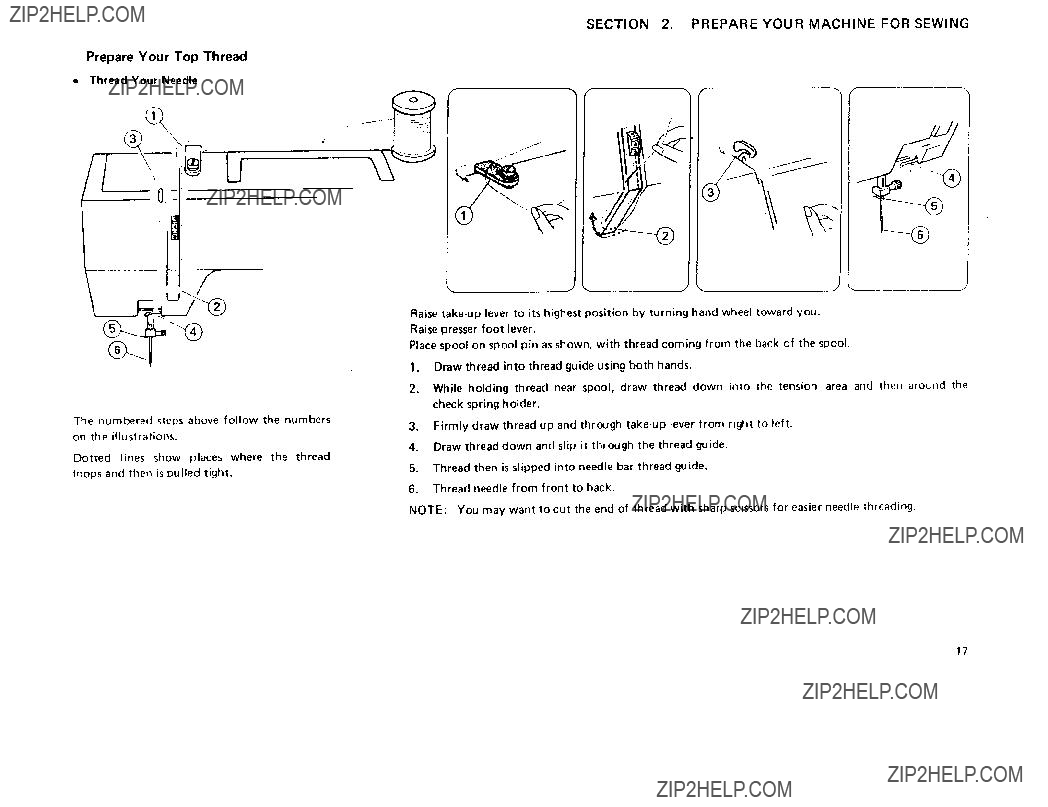
Prepare Your Top Thread
???Thread Your Needle
__r_
The numbered steps above follow the numbers on the illustrations.
Dotted lines show places where the thread loops and then is pulled tight.
SECTION 2. PREPARE YOUR MACHINE FOR SEWING
??
Raise
Raise presser foot lever.
Place spool on spool pin as shown, with thread coming from the back of the spool.
1.Draw thread into thread guide using both hands.
2.While holding thread near spool, draw thread down into the tension area and then around the check spring holder.
3.Firmly draw thread up and through
4.Draw thread down and slip it through the thread guide.
5.Thread then is slipped into needle bar thread guide.
6.Thread needle from front to back.
NOTE: You may want to cut the end of thread with sharp scissors for easier needle threading.
17
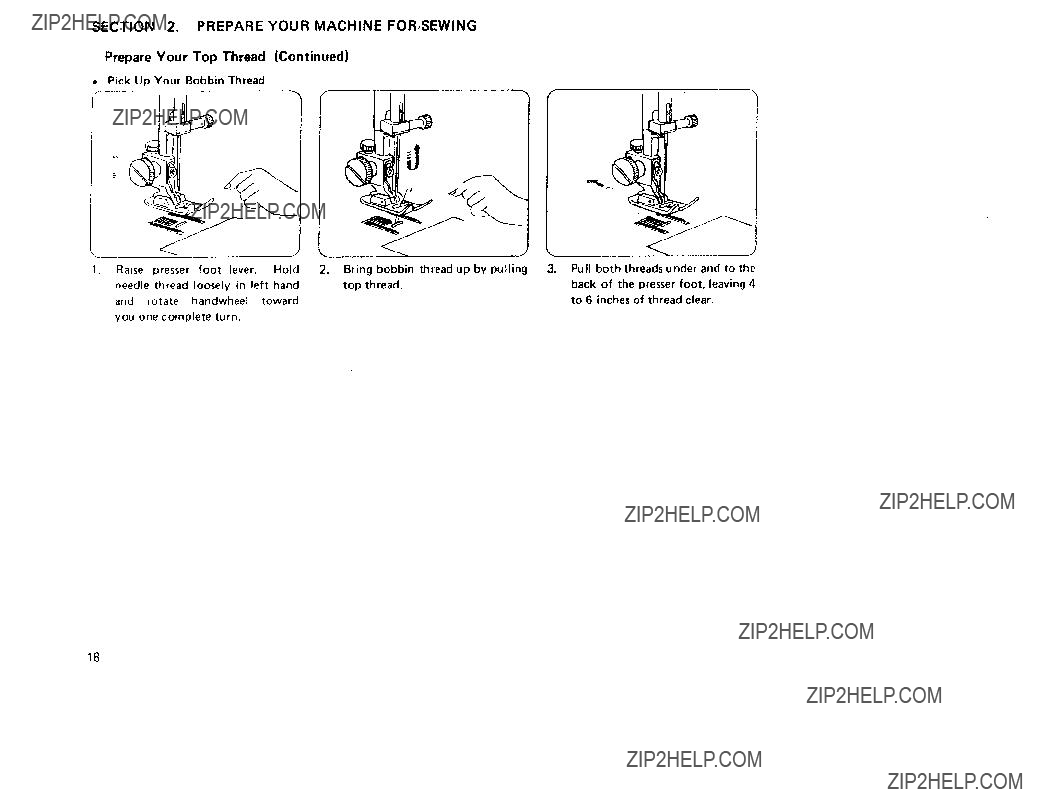
SECTION 2. PREPARE YOUR MACHINE FOR_SEWING
Prepare Your Top Thread (Continued)
???Pick Up Your Bobbin Thread
18

Adjust the Top Thread Tension
T_ p Siitp _,f fabric
Set tinq mark
Tlqht_rl
For Straight Stitch
The ideal straight stitch will have threads locked between the two layers of fabric, as shown above, magnified to show detail.
If you look at the stitch, front and back, you will notice that there are no gads, that each stitch is smooth and even.
When adjusting top thread tension, the higher the number, the tighter the top
thread.
SECTION 2. PREPARE YOUR MACHINE FOR SEWING
Choose the Correct Tension:
The best tension will depend on;
the stiffness and thickness of the fabric the number of fabric layers
the type of stitch
tabric,
19

SECTION 2. PREPARE YOUR MACHINEFOR SEWING
For Zigzag Stitct_l
In the correct zigzag stitch, the bobbin threads will not show on the top side of fabric and the top threads will show slightly on the bottom side. See below for the correct appearance. To match this appearance, adjust your top tension.
Stitch Selector
_0Stitch
Top tension
Too Tight
]_I_ _ide of gabrlC
r4r!!t!ir_, Side (d hat>tic
r+_f! _i!lht
--C(/r rler of each
_'iqzag wil! Dull toq_,lh_r _rl Pie top side of lilbrlcs.
Top tension
Too Loose
lop side of Fabric
Bottom side of Fabric
Too Loose
--The rOD thread
will loop through bottom side of fabric and will be
pulled almost together.
Just Right
Top side of Fabric
Bottom side of Fabric
Just Right
Minimize the amount
of top thread visible on the bottom side of
fabric without causing excessive puckering or causing the bobbin thread to show on the
top side. Results vary with fabric, thread and
sewing conditions.
Sel_tnf
The stitch selector control determines the stitch you select.
Simply turn this control until the desired stitch is indicated by the red indicat_ on the stitch indicator panel. The bottom row of stitches is selected when th+ stitch length control is set at the stretch stitch position.
NOTE: To avoid needle or fabric damage, be sure your needle is up and out01
fabric when selecting a stitch.
Stitch patterns are color+coded to recommend setting zones at the stitch lengl_
control.
ZONES
20
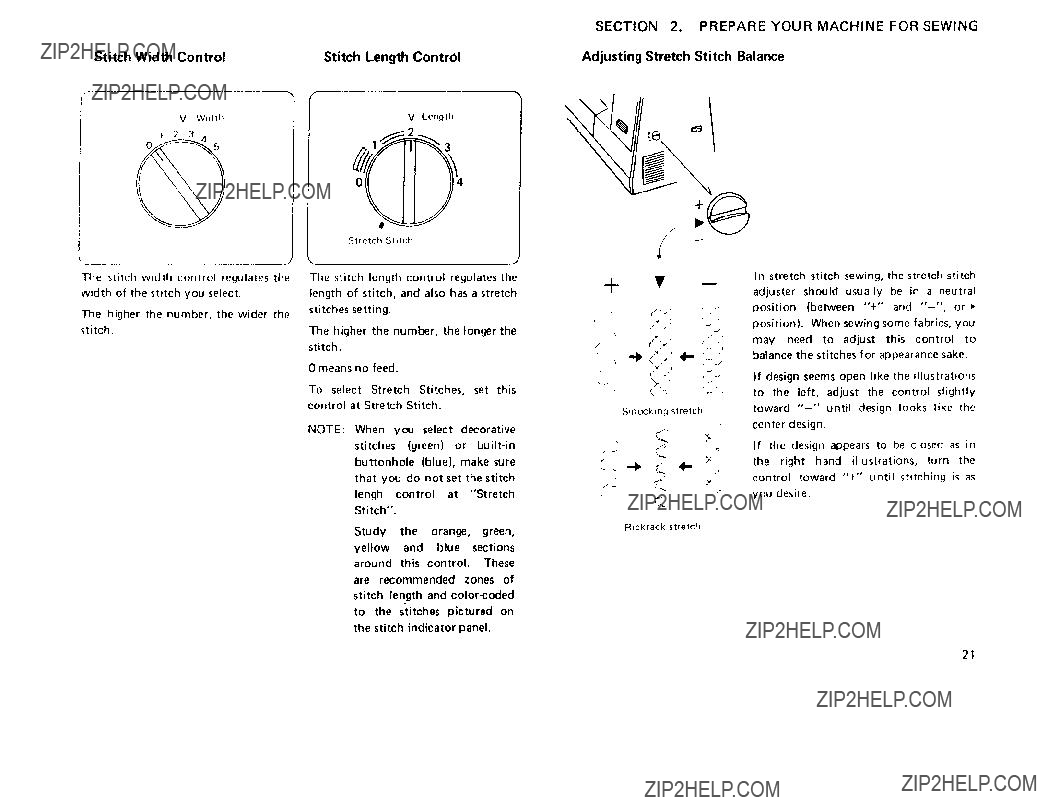
!2 3 4
SECTION 2. PREPARE YOUR MACHINE FOR SEWING
Adjusting Stretch Stitch Balance
The stitch width control regulates the width of the stitch you select,
The higher the number, the wider the
stitch.
0
l
Stretch Slitch
The stitch length control regulates the length of stitch, and also has a stretch stitches setting.
The higher the number, the longer the stitch.
0 means no feed.
To select Stretch Stitches, set this control at Stretch Stitch.
NOTE: When you select decorative stitches (green) or
/
4- ???
w ,
Smocking stretch
_L
In stretch stitch sewing, the stretch stitch adjuster should usually be in a neutral position (between "+" and .... , or ??? position). When sewing some fabrics, you may need to adjust this control to balance the stitches for appearance sake.
If design seems open like the illustrations to the left, adjust the control slightly toward
If the design appears to be closed as in the right hand illustrations, turn the control toward "+" until stitching is as you desire.
Study the orange, green,
yellow and blue sections around this control. These
are recommended zones of stitch length and
Rickrack stretch
21

SECTION 2. PREPARE YOUR MACHINE FOR SEWING
Reverse
To reverse stitch, hold down this con- trol during sewing.
Release to sew forward again.
Now that you are familiar with the controls on your machine and with the accessories provided for the machi_ you are ready to start to sew with your new Kenmore sewing machine. Below are some good habits to foIff each time you sit down to sew:
1. Inspect the needle. It should be straight, properly set and sharp on the point. It should be the correct si for the fabric and thread being used. Do not be afraid to change your needle frequently. Many of the n_ fabrics made of synthetic blends tend to dull the needles more easily than fabrics made of natural fibers,
2.Before placing the material on the machine, see that the ends of the threads have been drawn about inches to the rear of the machine. Hold on to threads during the sewing of the first3or4stitchesoft
seam.
4.Fabric should be placed under the presser foot with the bulk of the material to the left of the needle the right edge of the material placed on the 5/8" seam marking on the needle plate when making a sirnp seam.
5.Run the machine at a slow even speed. The more pressure you put on the foot control, the faster l machine will sew.
6.Fasten each seam by back tacking at the beginning and end of the seam.
7.Always finish sewing each seam with the needle at its highest point.
8.Guide the fabric gently with your hand in front of the needle. Never pull or hold the fabric in such a_ that the normal feeding is altered.
9.When turning the hand wheel manually, always turn it toward you.
22

Practical Stitch Chart
Stitch
StitchSelection
STRAIGHT
I
I
I
I
STRAIGHT
STRETCH
III lu
III
In
ZIGZAG
STRETCH
t
BLINO HEM
STITCH
%Chart
on p. 14
%onp. 14
Chart
%on p, 14
Stitch
Length
Orange
Zone
Yellow
Stretch
Stitch
Position
Orange
Zone
Yellow
Stretch
Stitch
Position
Orange
Zone
SECTION3. LEARN THE STITCHES
23

SECTION 3. LEARN THE STITCHES
Practical Stitch Chart (Continued)
Needle
Check
Chart
onD. 14
Check
Chart
on p. 14
Check
Chart
onp. 14
Stretch
Stitch
Position
Refer to Page
38
37
51
Check
Chart
onp. 14
Blue (11 ) onp, 14
Stretch
Stitch
Position
Finish hems, sleeve and neck openings, Use on nylon tricot and other lingerie to overcast and seam,
Oo shell tucking on blouses and lingerie.
Finish hems, sleeve and neck openings. Use on nylon tricot and other lingerie to overcast and seam.
Do shell tucking on blouses and lingerie.
5O
38
24

Needle
Thread
Stitch
Stitch
SECTION 3. LEARN THE STITCHES
C_ %
Tension
Check3_8 Chort
on p. 14
Check3~6
Chart
onp. 14
Check3~8
Chart
on p. 14
Check2-6
Chart on_. 14
Length
Orange
Zone
Yellow
Stretch
Stitch
Position
0.5_2
Yellow
Stretch
Stitch
Position
Orange
Zone
Width
3_5
25
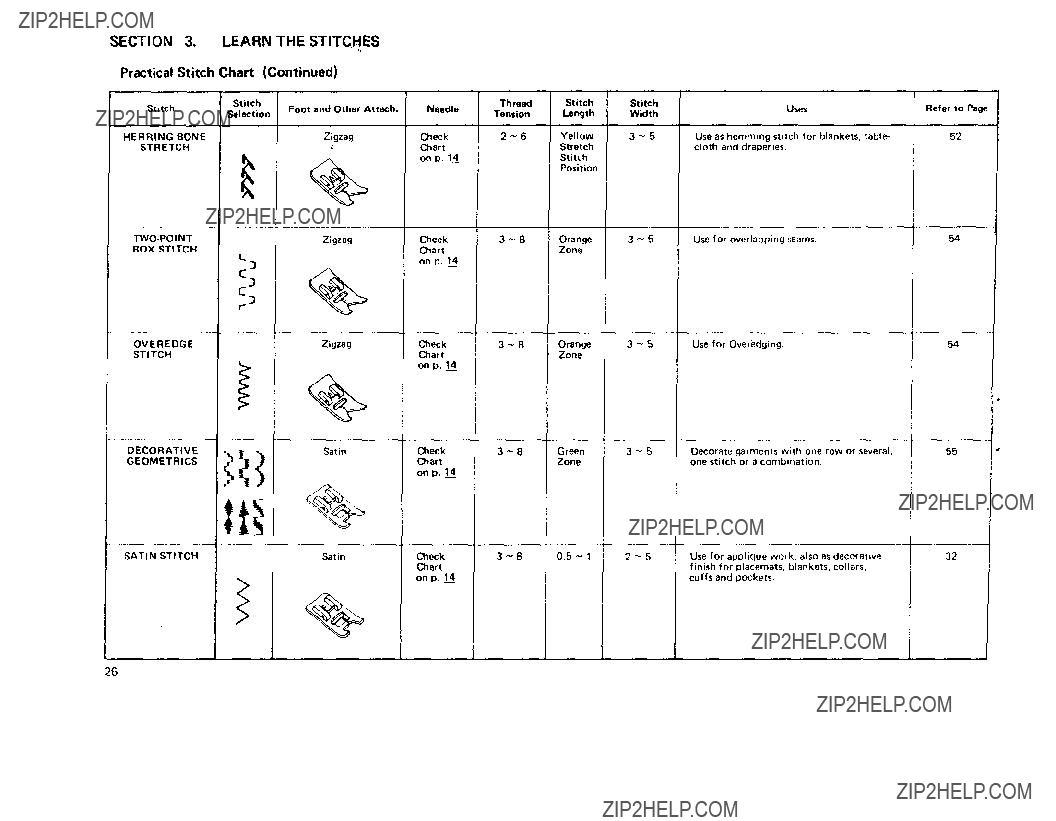
SECTION 3. LEARN THE STITCHES
Practical Stitch Chart (Continued)
on p. 14
3_8O_nge
Zone
Stitch
Width
3_5
3_5
3_5
2_5
Uses
Use as hemming stitch for blankets, table- cloth and draperies.
Use for overlapping seams
Use for Overedging.
Decorate garments with one row or several, one stitch or a combination.
Use for applique work, also as decorative finish for placemats, blankets, collars, cuffs and pockets.
Refer to Page
52
54
54
55
32
26

BUTTONHOLE
D
%
97

SECTION 3. LEARN THE STITCHES
Straight Stitches
Straight Stitch
Set the Machine
Stitch width
coT::.
Stretch Stitch
H Straight foot
NOTE; Best sewing results are obtained with the straight stitch foot, but the zigzag foot will also provide acceptable results.
Before sewing with the straight stitch foot, always set the stitch width control to 0 to avoid breaking the
needle.
1.Raise the presser foot.
2.Raise the needle to its highest position.
3.Place the edge of the fabric next to a stitching guide line on the needle plate (5/8" is most common).
4.Draw the threads toward the back and lower the presser foot.
5.Press the foot control.
6.Hold the fabric loosely and gently guide it along the guide line, so that it feeds naturally.
[)o n=ot for_ce t.he fa_)ric or try to pull it tight.
7.At the beginning and end of seam, you may want to reverse to lock the stitch.
8.Raise the presser foot and remove the fabric.
9.Cut the threads.
Use the Seam Guides
The seam guides on the needle plate are engraved to help you measure seam width. The lines are 1/8" apart, with the 5/8" and 7/8" lines marked.
Turn a Square Corner
To turn a square corner .5/8" from the fabric edge:
1.Stop stitching and lower the needle by turning hand wheel toward you when the fabric edge facing you lines up with the cornering guide, as shown,
2.Raise the presser foot and turn the fabric to line the edge with the 5/8" seam guide???
3.Lower the presser foot and begin stitching in the new direction.
28

SECTION 3. LEARN THE STITCHES
???Use the Darning Plate
DarNing 01ate
\
Sometimes when you sew, you want to control the fabric yourself. The Darning Plate covers the feed dogs so that they do not touch the fabric.
To Put on the Darning Plate:
NOTE: The rectangular holes in the Darning Plate match the holes in the needle plate. In the darning plate, these holes are slightly to the right of center.
1.Position the darning plate with the pins on the bottom.
2.Fit the darning plate pins into the needle plate holes at the 5/8" mark. The feed dogs will show through the darning plate holes,
Use the darning plate in the following ways:
Darning (see page 30),
Button Sewing (see page 35)
Topstitching
Set the Machine
Stitch width
1234
Stretch Stitch
H: Straight foot
The Stitch and tts Uses
Topstitching emphasizes the lines of your garment and keeps seams and edges flat and crisp.
Accent suits or blouses with one or two rows of topstitching around the outer edges of cuffs, lapels or collars.
Here'sHow
1.Lower the presser foot.
2.Keep the edge of the fabric next to the right edge of the presser foot.
3.Evenly guide the fabric along this edge to produce an even row of topstitehing 5/8" from the edge.
29

SECTION 3. LEARN THE STITCHES
Darning
Sot the Machine
Stitch width control O
Straight Stretch
Set the Machine
oroStitch width
1 2 3 4
Top thread
tension
control 2 to6
No presser
foot
Darning plate
Stitch length control any number
(no_ necesF.3ry to
adjust)
Here's How
2
1.Put the darning plate on the needle plate
(see page 29).
2.Remove presser foot and foot holder (see page 10), stretch fabric between
Stretch Stitch
embroidery hoops with hole centered.
3.Draw the bobbin thread up through the fabric by holding the top thread and taking one stitch at the spot where you wish to start darning.
4.Lower the presser bar and sew at a slow
speed.
position
2
clothes).
NOTE: If your fabric is thin or badly damaged, use a separate piece of fabric under the hole to reinforce it.
This stitch can also be used for
topstitching on all fabrics,
The stretch stitch does net actually stretch as it is being sewn, but is stitched in a forward and back motion (sometimes called a "reverse??? action" stitch), so that it will give when the fabric stretches
7.When you finish darning, remove the darning plate and replace foot holder and foot.
instead of breaking.
3O
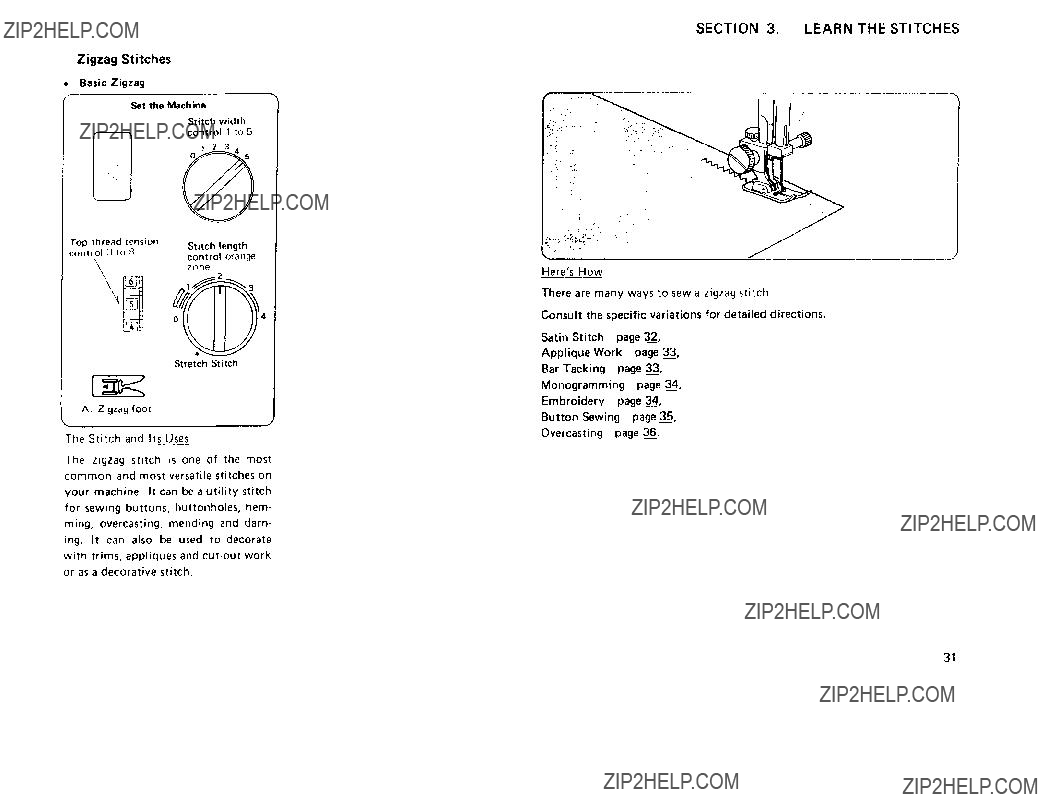
Zigzag Stitches
Basic Zigzag
Set the Machine
Stitch width control 1 to 5
??
Stretch Stitch
A: Zigzag foot
The Stitch and Its Uses
The zigzag stitch is one of the most
common and most versatile stitches on your machine. It can be a utility stitch for sewing buttons, buttonholes, hem- ming, overcasting, mending and darn- ing. It can also be used to decorate with trims, appliques and
or as a decorative stitch.
SECTION 3. LEARN THE STITCHES
!iiil ???
Here's How
There are many ways to sew a zigzag stitch
Consult the specific variations for detailed directions.
Satin Stitch page 32,
Applique Work page 33,
Bar Tacking page 33,
Monogramming page 34,
Embroidery page 34,
Button Sewing page 35,
Overcasting page 36.
31

SECTION 3. LEARN THE STITCHES
Zigzag Stitches (Continued)
???Satin Stitch
Set the Machine
Stitch width
Top thread tension
control 3 lo_Stitch length control 05 to 1
2
Stretch Stitch
F:Satin stitch foot
Pressure dia!: I or
The Stitch and Ifs Uses
The Satin stitch is a versatile and often used decorative stitch, but it can also he used to overcast a raw edge (for ex- ample, blankets, linens, tablecloths and napkins).
]'he Satin stitch is especially attractive in applique.
Zigzag width
Stitch
length
4
(
CIos, _ It3 0
Here's How
Once your machine is set up to stitch, you may want to experiment on a fragment of the fabric you are planning to use. Too tight satin stitch may pucker some light weight fabrics,
32

SECTION 3. LEARN THE STITCHES
conStitch widthro,2,oStitch width
??1 3 4
control to 5
or left.
r
This stitch is similar to a very short
satin stitch and is used to reinforce poi_lts of strain such as corners or pockets and straps on lingerie.
Sew 4 to 6 zigzag stitches
33

SECTION 3. LEARN THE STITCHES
Zigzag Stitches (Continued}
???Monogramming
_t the Machine
Stitch width
1 2 3 4HA
Embroidery
Set the Machine
Stitch width control 1 to 5
I 2 3 4
Stretch Stitch
F: Satin StitCh
foot
Here's How
1.Set the same as satin stitch.
2.Back the fabric with paper or interfacing,
3.Draw the letters on the fabric with tailor'schalk.
4.Satin stitch, adjusting the stitch width as necessary to form each pattern.
5.If using paper, carefully remove it when you have finished sewing.
7.Holding the top thread in your left hand, rotate the hand wheel toward you one complete turn.
Putl the top thread to draw the
bobbin thread through to the surface
of the fabric.
8.Using a medium speed, stitch along the marked outline, ??uiding the fabric carefully by hand.
34

???Sew a Button
S_t the Machine
Stitch width control
M_sr be adjusled
Top thread tension control 2 to 6
Stitch length control Any number (not necessary to adjust)
SECTION 3. LEARN THE STITCHES
Stretch Stitch
Zigzag foot
A:t_
Use the darning plate for button sewing (see page 29).
1.Match the center of the button hoJes to the center of the slot on the presser foot.
2, Adjust the stitch width so that needle will drop in each hole.
3.Lower the foot to hold the button in place.
Turn the hand wheel by hand so that needle will enter either hole of the button.
To strengthen the sllank, cut the threads leaving a B" tail. Bring the needle thread down through the hole in the button and wind it around the shank.
Draw the thread to the bottom side and knot.
Darning pla
4.Stitch several times.
35

SECTION 3. LEARN THE STITCHES
Zigzag Stitches (Continued)
Overcasting Stitch
Set the Machine
Stitch width
??1 2 3 4 ,
control 3 to 5
Stretch Stitch
A: Zigzag foot
Helpful Hints
Start overcasting about 1/8" inside the raw corner of your seam, If you start right at the edge, the fabric will bunch up and the stitches will become tangled:
Set the Machine
Stitch width control 2 to 5
Top thread tension control 2 to 6
Stitch length
Stretch Stitch
A:Zigzag foot
The Stitch and Its Uses
This zigzag variation is very useful in garment construction and in finishing raw edges of any sewing project.
36

SECTION3. LEARN THE S:FITCHES
Set the Machine
Stitch width control5
1234
Fop thread tension
control 2 to 6
Stitch length
control 0 5 to 1
Seam Finishing (Overcasting)
Place the fabric under the presser foot so that the edge will be slightly inside the right hand side of the presser foot.
Guide the work so the right hand
Stretch Stitch
stitches fall at the edge of the fabric???
The
The
mending
sewing patches smoothly and securely
repairing straight tears. finishing seams
Mending
Position the tear under the needle so
that the stitching will catch both sides.
37
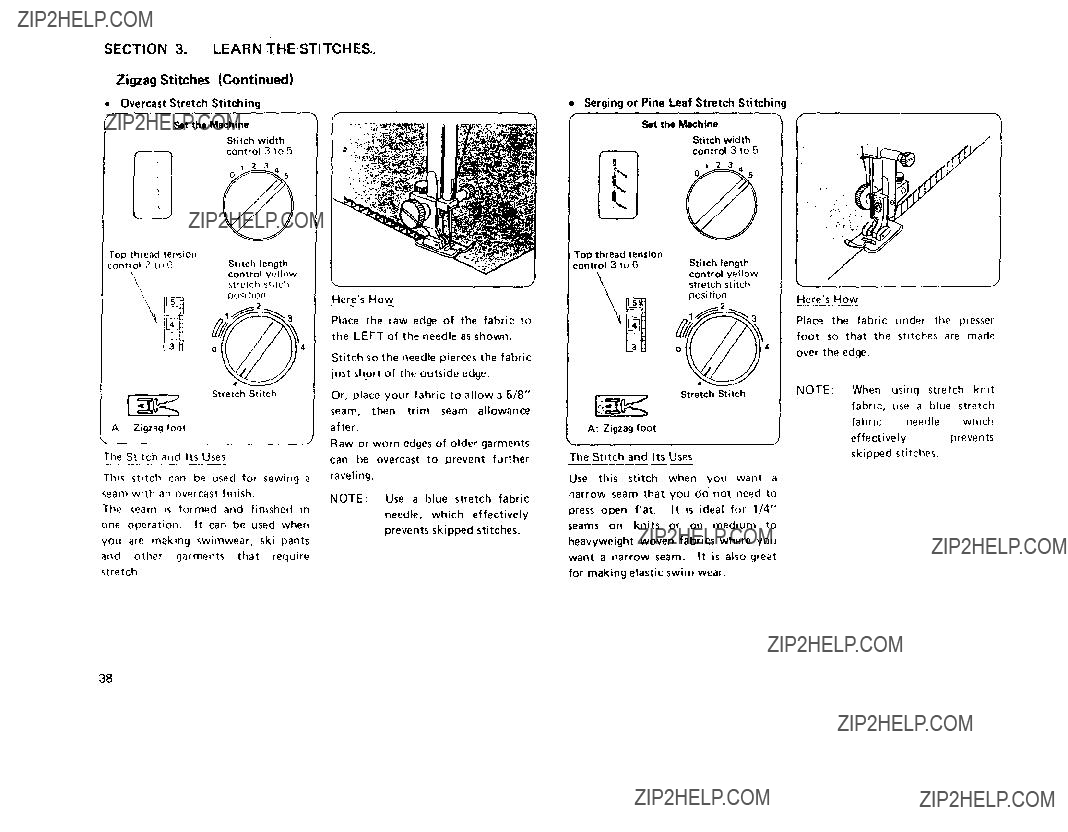
SECTION 3. LEARN THESTITCHES,
Zigzag Stitches (Continued)
Overcast Stretch Stitching
Set the Machine
Stitch width
control 3 !o5
Serging or Pine Leaf Stretch Stitchim
Set the Machine
Stitch width
I_O';I tl(_rl
Here's How
Top thread tension
control 3 to (3Stitch length control yellow stretch stitch
position
Here's.How
Stretch Stitch
A Zigzag foot
The Stitch and Its Uses
This stitch can be used for sewing a seam with an overcast finish.
The seam _s formed and finished m one operation It can be used when you are making swimwear, ski pants and other garments that require stretch
Place the raw edge of the fabric to the LEFT of the needle as shown.
Stitch so the needle pierces the fabric just short of the outside edge.
Or, place your fabric to allow a 5/8" seam, then trim seam allowance after.
Raw or worn edges of older garments can be overcast to prevent further
raveling.
NOTE: Use a blue stretch fabric
needle, which effectively
prevents skipped stitches.
Stretch Stitch
A: Zigzag foot
he Stitch and Its Uses
Use this stitch when you want a narrow seam that you do not need to press open flat. It is ideal for 1/4" seams on knits or on medium to heavyweight woven fabrics where you want a narrow seam. It is also great for making elastic swim wear.
Place the fabric under the presser foot so that the stitches are made over theedge.
NOTE: When using stretch kmt fabric, use a blue stretch fabric needle which effectivelyprevents skipped stitches.
38

Blind Hemming
Stretch Stitch
A Zigzag foot
SECTION 3. LEARN THE STITCHES
1/4"
\
1.Finish the raw edge of your hem an,/way you desire. (See overcrasting page 36).
2.Measure, turn up your hem and pin.
3.Fold the material (bottom side out) on the edge to be stitched, as shown, leaving 1/4- of the finished hem edge showing.
4.Place garment under presser foot in such a manner that straight stitches will be sewn on extended edge. The zigzag stitch should just catch the fold of the garment.
5.After hemming, press both sides of the finished hem. The top side of the garment will show only the blind stitches.
39

SECTION 3, LEARN THE STITCHES
Lace Work
Set the Machine
Stitch width
Stretch Stitch
A Zigzag foot
.
YY
Lace adds a fanciful, feminine touch to blouses and lingerie. Table linens and pillows become more elegant when trimmed with lace,
Turn raw edge of fabric under at least
5/8". Place lace underneath and top- stitch using stretch blind hem stitch.
Trim excess fabric close to stitching.
4O
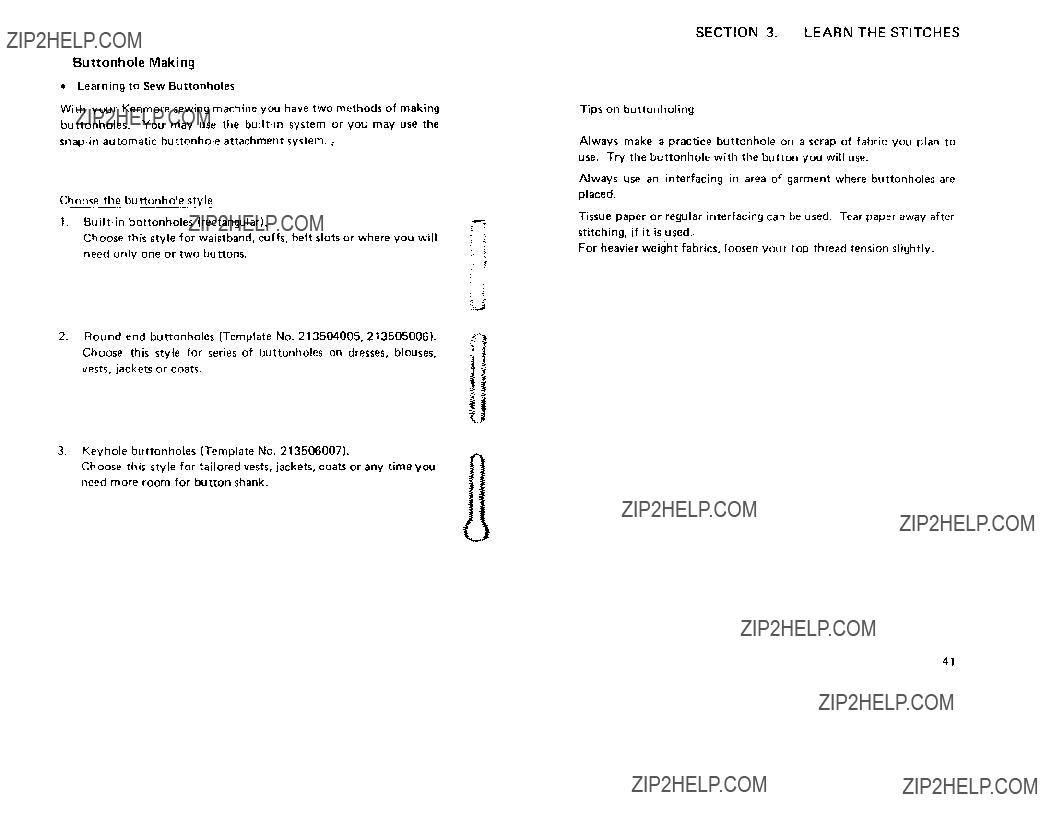
Buttonhole Making
???Learning to Sew Buttonholes
Choose the buttonhole style
1.
Choose this style for waistband, cuffs, belt slots or where you will need only one or two buttons.
_J
2. Round end buttonholes (Template No. 213504005, 213505006). Choose this style for series of buttonholes on dresses, blouses, vests, jackets or coats.
3.Keyhole buttonholes (Template No. 213506007).
Choose this style for tailored vests, jackets, coats or any time you need more room for button shank.
SECTION 3. LEARN THE STITCHES
Tips on buttonholing
Always make a practice buttonhole on a scrap of fabric you plan to use. Try the buttonhole with the button you will use.
Always use an interfacing in area of garment where buttonholes are placed.
Tissue paper or regular interfacing can be used. Tear paper away after stitching, if it is used..
For heavier weight fabrics, loosen your top thread tension slightly.
41

SECTION 3. LEARN THE STITCHES
Buttonhole Making (Continued)
???
Set the Machine
Stitch width control i_ lfl S
IRlue zone1
0 _ 2 345
2.a. Move the slider (A) toward you so that the top mark (C) on the slider meets the start mark (B).
b.Line up the markings on the foot with the top mark on your garment.
c.Lower the presser foot.
4
3.a, Set the stitch selector at _'I
b.Sew folwatd until you reach the front marking of you{ button. hole.
e Stop sewlltg at the left shteh
42
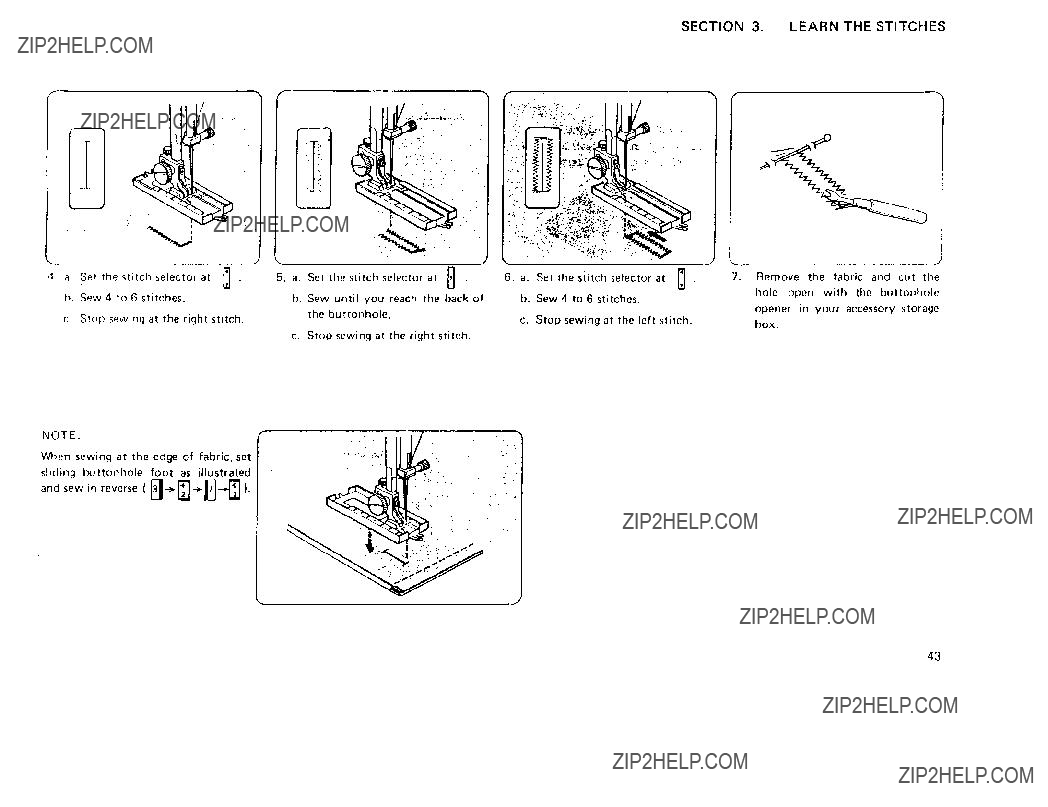
SECTION 3. LEARN THE STITCHES
m
,_ Set the stitch selector at 1,1 b. Sew 4 to 6 stitches.
c Stop sewing at the right stitch???
??. Stop sewing at the right stitch.
sliding buttonhole foot as illustrated
43

SECTION 3. LEARN THE STITCHES
Buttonhole Making (Continued)
???Using Buttonhole Attachment
Buttonhole Attachment System
For more varied and accurate buttonholes, you will enjoy using the button- hole attachment and templates. Know the parts read carefully how to set up your machine properly. You will need these items for the buttonhole attachment system.
Gl_ide s_ot
/MeaStl rerflerl t marking
Catch
Buttonhole wide plate
Guide block
Buttonhole templates
Base plate
Buttonholefoot
Buttonhole Style and Size
NOTE: Illustrations of buttonhole on template show actual length of buttonhole to be sewn. You will find the most suitable buttonhole length easily by matching the button with the proper illustration' on the template.
44

Set the Machine
Stitch width
control 2
' "Top thread tension
I (:c_ntrol 2 l=_ G
Stitch length
2
_contrOIo_j_
Stretch Stitch
Buttonhole foot
Helpful Hints
You can obtain best results to use =60 _
NOTE: It is advisable to use a blue stretch fabric needle when
sewing knits and synthetic fabrics.
You can obtain buttonholes with a wider cutting space by setting the stitch width control at 1.5 instead of 2.
SECTION 3. LEARN THE STITCHES
Pins (A)
1.a. Remove the extension table.
b. Raise the needle to its high,.=st position.
c.Remove the foot holder.
d.Pull bobbin thread out about 3" straight back toward rear of machine.
e.Insert hook of base plate into rectangular hole of needle plate.
f.Pull lever back to align the hook with the rectangular hob.
g.Snap base plate down to fit two pins (A) at the back of base plate into two round holes (B) on needle plate.
Release lever.
45

SECTION 3. LEARN THE STITCHES
Buttonhole Making (Continued)
Template
GiJid
/"C_tcb Setting Mark
Gqide block
plate
2.a. When you have selected the template with the size and style button- hole you need, slide the template into the guide plate.
b.Pull catch toward you while sliding the template until the button- hole size you have chosen is at the setting mark.
c.Insert gear of base plate into slot of template and fit guide block into the center of the guide slot.
Top thread
@
I
',\
\
Starting
_)[)qgl l
Bobbin thread
3.a. Attach the buttonhole foot.
b.Adjust position of gear so it is aligned with the starting point of template.
The lever can be used to change gear position.
c.Pull the bobbin thread up through guide slot by turning the hand whee! toward you while holding top thread.
d.Place the bobbin and top threads to the left side of guide plate, Leave 3 to 4 inches of thread.
46

4a. Mark your buttonhole position carefully on the garment.
b.Placing your garment behind the machine, insert it between the guide plate and the buttonhole foot as shown.
c.Align marked buttonhole with center marking on buttonhole foot,
SECTION 3. LEARN THE STITCHES
5.a. Lower the buttonhole foot.
b, Start sewing slowly.
c. Allow the machine to do the work by itself. (Do not try to guide the fabric.)
d. Stop sewing when the needle returns to the position where it begins,
To release the buttonhole base plate, pull the lever toward you and lift the base plate off the machine,
Adjusting the stitch density
You may alter the closeness of the stitches by turning the stitch length control from 4 to 3.
2_ fabrics
I! 2 Fine stitches for light
Stitch length control 4
_2
for heavy fabrics
4
Stretch Stitch
47

SECTION 3. LEARN THE STITCHES
Sew in a Zipper
_,f f,qt_r i_
_(1/8")
/Zi_lper te_th
Zipper tape
To Sew:
1. Reset stitch length at 2 and top
thread tension at 2 to 6,
Fold back the left seam allowance
as shown.
4.Attach the presser bar to the right pins on the zipper foot.
5.Lower the zipper foot on the top
side at the bottom of the zipper so that the needle pierces the fold and the zipper tape.
[upedge of fabric
-
The ifin on the h?f [ hand side
Stretch Stitch
E:Zipper foot
To attach the zipper foot:
attach the presser bar to the right pins
on the zipper foot.
???To sew on the right side of the zipper, attach the presser bar to the left pins on the zipper foot.
3.Place the zipper teeth next to the 1/8"fold and pin in place.
6.Sew through the fold and the zipper tape to the point where the slider begins,
7.Lower the needle to hold the fabric and raise the presser foot.
48
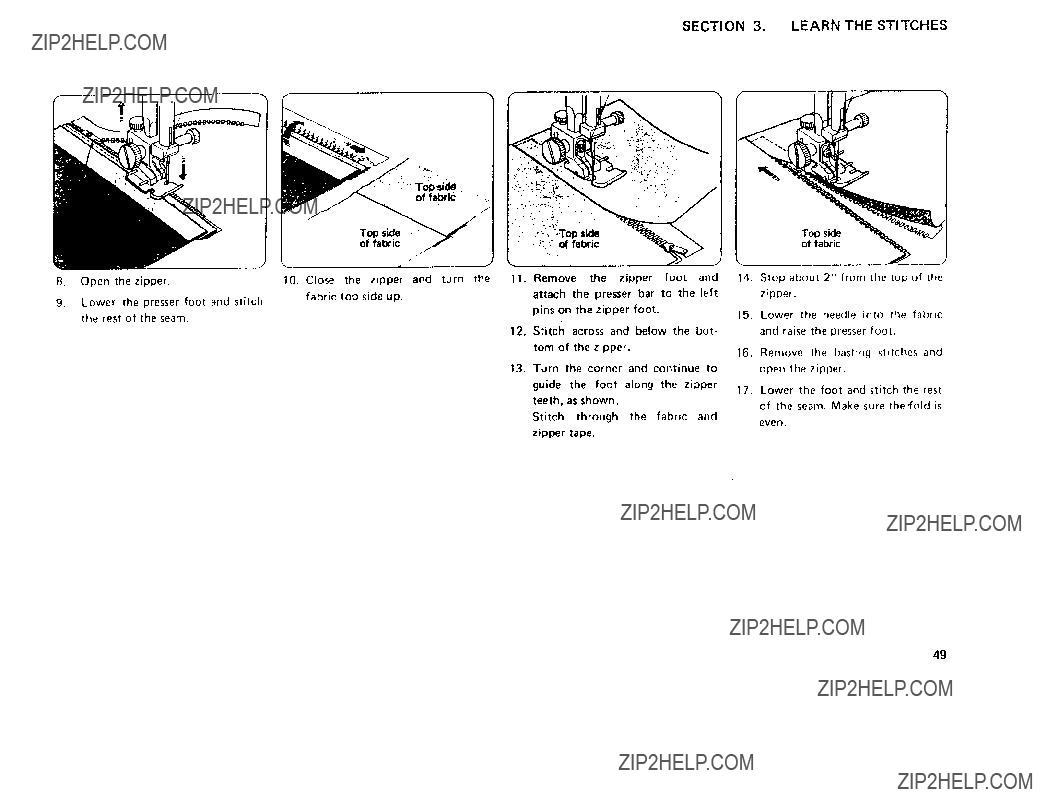
SECTION3. LEARNTHESTITCHES
the rest of the seam,
i
11.Remove the zipper foot and attach the presser bar to the left pins on the zipper foot.
12.Stitch across and below the bot- tom of the zipper,
13.Turn the corner and continue to
guide the foot along the zipper teeth, as shown.
Stitch through the fabric and zipper tape.
Top side of fabric
14.Stop about 2" from the top of the zipper.
15.Lower the needle into the fabric and raise the presser foot.
16.Remove the basting stitches and open the zipper.
17.Lower the foot and stitch the rest of the seam. Make sure the'fold is even,
49
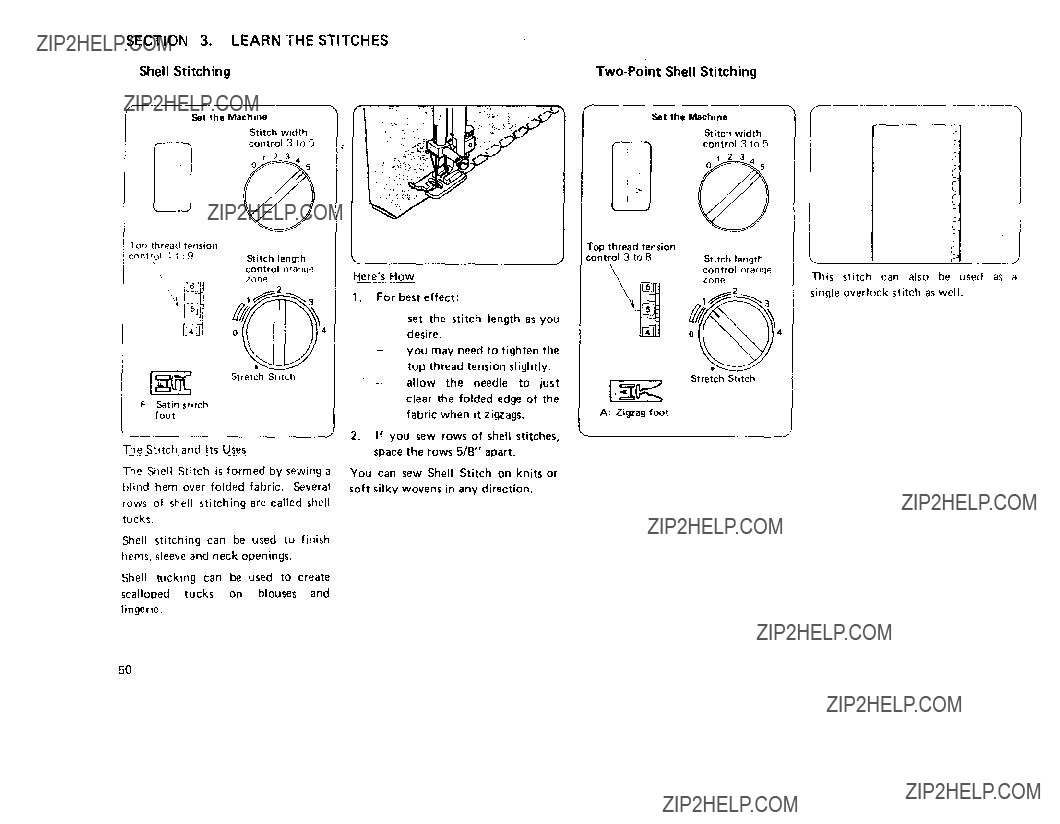
SECTION 3. LEARN THE STITCHES
Shell Stitching
Set the Machine
FSet the Machine
Stitch width
control 3 to
??I 2 3 4
I Top thread tension
ZOne
,4!
y _: " ":"S_
He re'1;.Ho_w
Top thread tension control 3 to S
Stitch width
Stitch length control _ran_ e
zon(_
This stitch can also be used as a
,,,,ii, It
The Shell Stitch is formed bv sewing a blind hem over folded fabric. Several rows of shell stitching are called shell tucks???
Shell stitching can be used to finish hems, sleeve and neck openings.
Shell tucking can be used to create scalloped tucks on blouses and lingerie
1.For best effect:
set the stitch length as you desire.
-you may need to tighten the top thread tension slightly.
-allow the needle to just clear the folded edge of the fabric when it zigzags.
2.If you sew rows of shell stitches, space the rows 5/8" apart.
You can sew Shell Stitch on knits or soft silky wovens in any direction.
single overlock stitch as well.
Stretch Stitch
A:Zigzag foot
5O

Smocking
Set the Machine
Stitch width
control 3 to 5
Stretch Stitch
A Zigzag foot
SECTION 3. LEARN THE STITCHES
Stretch Patching
Set the Machine
Stitch width
control 5
??op thread tension Stitch length control control 2 to 6
yellow stretch stitch position
The Stitch and its Uses
For patching worn out elbows or
knees.
Stretch Stitch
A: Zigzag foot
With the stitch length at "4". sew straight stitching lines 3/8" apart across the area to be smocked.
Knot the threads along one edge. Pult the bobbin threads and distribute the gathers evenly. Secure the threads at the other end. Sew the decorative stitch between the gathering stitches. Pull out the gathering stitches.
NOTE: Loosen the top thread tension to make gathering easier.
51
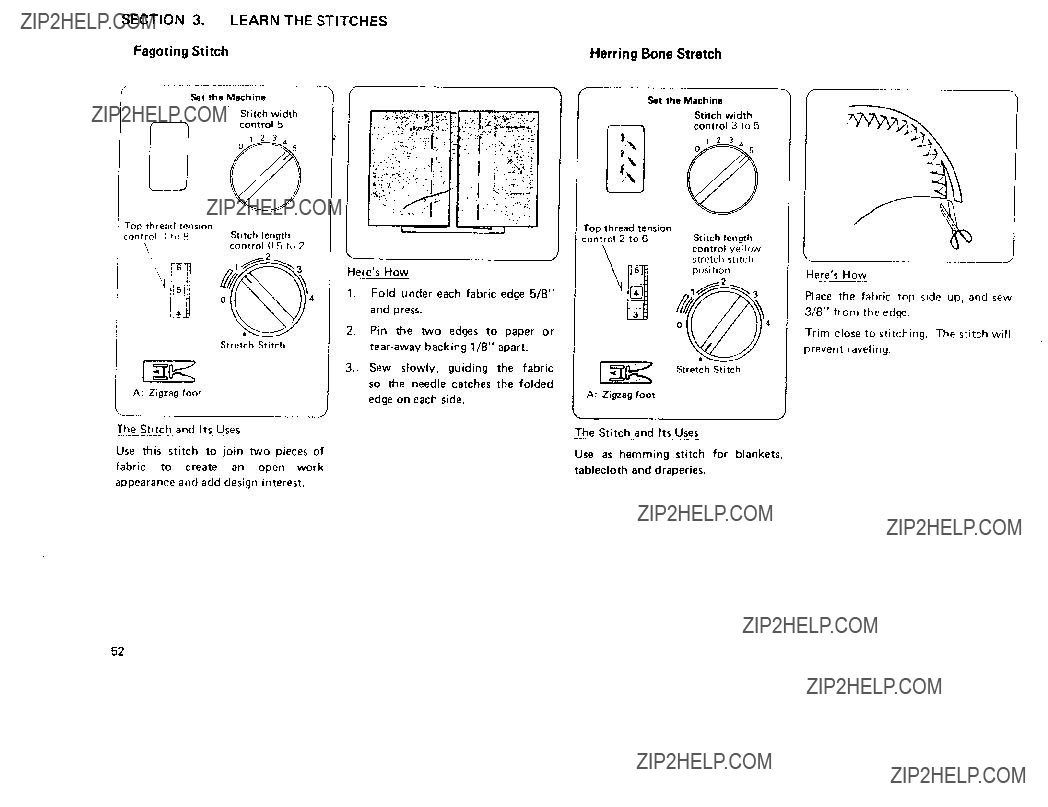
SECTION 3. LEARN THE STITCHES
Fagoting Stitch
Set the Machine
Stitch width
Herring Bone Stretch
f
Set the Machine
Stitch width
I 2 3 4
,<
???l,si_
Stretch Stitch
A: Zigzag foot
The Stitch and Its Uses
Use this stitch to join two pieces of fabric to create at1 open work appearance and add design interest.
Here's How
1.Fold under each fabric edge 5/8" and press.
2.Pin the two edges to paper or tear away backing 1/8" apart.
3..Sew slowly, guiding the fabric so the needle catches the folded edge on each side.
A:Zigzag foot
The Stitch and Its Uses
Use as hemming stitch for blankets,
tablecloth and draperies.
Here's How
Place the fabric top side up, and sew 3/8" from the edge.
Trim close to stitching. The stitchwill prevent raveling.
52
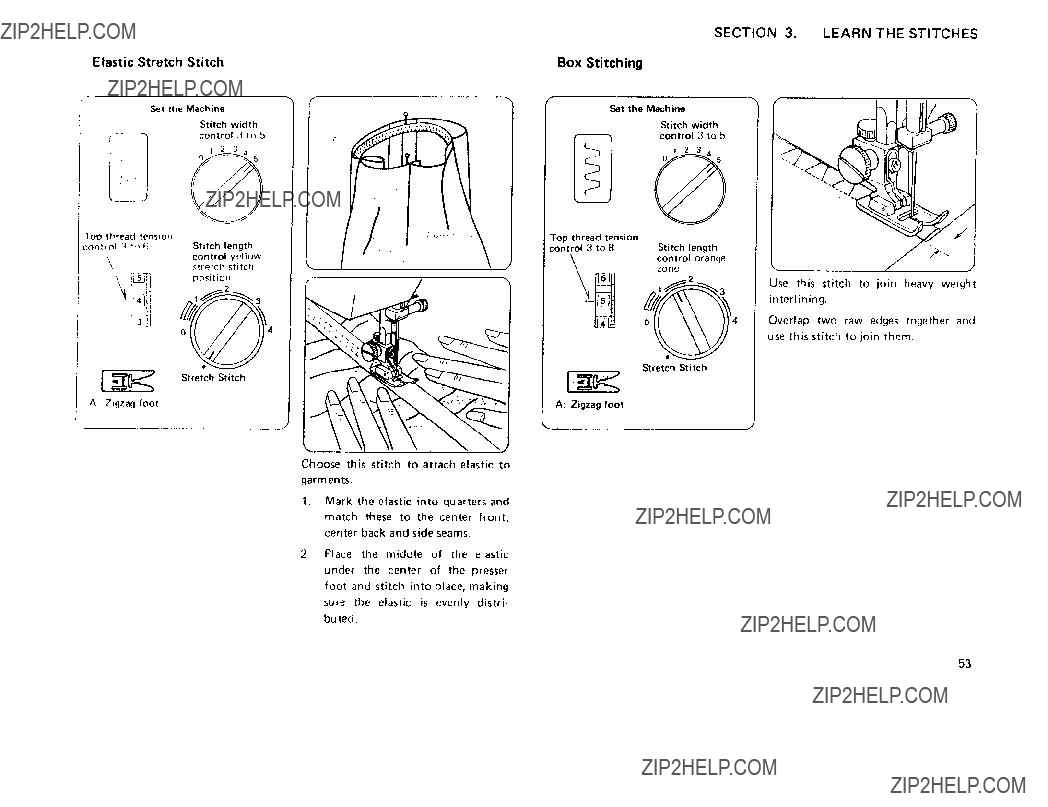
ElasticStretch Stitch
Set the Machine
Stitch width
ToD thread tension
_tretch stitch
p_S_tlon
i ,lll
Stretch Stitch
A Zigzag foot
/
Choose this stitch to attach elastic to garments.
1.Mark the elastic into quarters and match these to the center front, center back and side seams.
2.Place the middle of the elastic under the center of the presser foot and stitch into place, making sure the elastic is evenly distri- buted.
SECTION3. LEARNTHESTITCHES
Box Stitching
Set the Machine
Stitch width
Use this stitch to join heavy weight interlining.
Overlap two raw edges together and use this stitch to join them
Stretch Stitch
A: Zigzag foot
53

54

Decorate with Geometric Patterns
Set the Machine
Stitch width control 3 to 5
Top thread tension control 3 Io8
'\
Stitch length control green
zone
o
F: Satin stitch
Tile Stitches and T!leir Uses
These stitches are purely decorative.
You can sew one row or several or vary the stitch width and length for
special effects.
Experiment on a scrap of fabric to see what special effects are possible.
,SECTION 3. LEARN THE STITCHES
i I ,
Here's How
1.Adjust the stitch width and tength as you desire.
2.Practice the stitch on a scrap of" fabric.
3.Mark the lines for decoration on the fabric, using a washable fabric marker.
4.Lower the needle at the starting point.
5.Lower the presser foot.
6.Gently guide the fabric along the maked line.
55

56
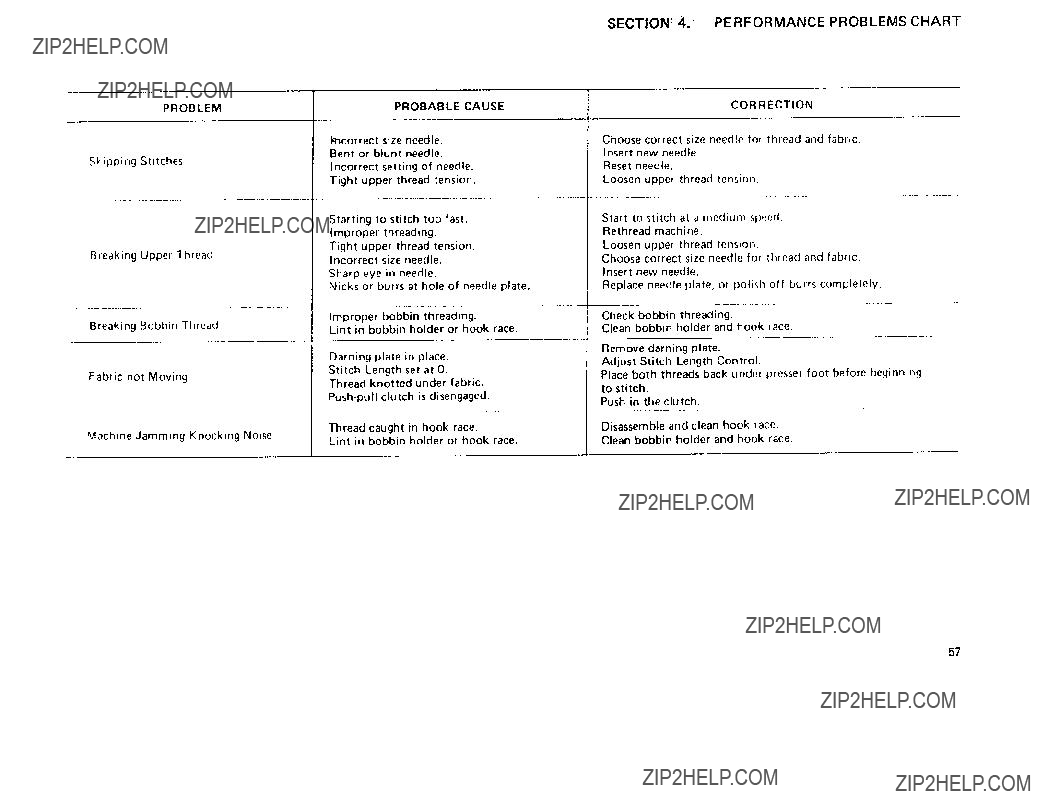
PROBLEM
Sk;ppmg Stitches
Breaking Uppel Thlead
PROBABLE CAUSE
t_correct size needle, Bent or blunt needle.
Incorrect setting of needle.
Tight upper thread tension.
Starting to stitch too fast. improper threading.
Tight upper thread tension.
Incorrect size needle.
Sharp eye in needle.
Nicks or burrs at hole of needle plate.
CORRECTION
Choose correct size needle for thread and fabric.
Insert new needle.
Reset needle.
Loosen upper thread tension.
Start to stitch at a medium speed.
Rethread machine.
Loosen upper thread tension.
Choose correct size needle for lhread and fabric.
Insert new needle.
Replace needle plate, or polish off burrs completely.
Check bobbin threading.
Clean bobbin holder and hook race???
Remove darning plate.
Adjust Stitch Length Control.
Place both threads back under presser foot before beginning to stitch.
Push in the clutch.
Disassemble and clean hook race.
Clean bobbin holder and hook race.
57

SECTION 5. CARE FOR YOUR MACHINE"
To insure that your machine operates at its best, you need to keep the essential parts clean at all times.
The bobbin area can attract dust and lint. Your machine can become sluggish or knock loudly if a thread is caught.
Lh_plug the machine and open the
{;_cP covPr
Put the new btdb in by pushingit up arid ttlt[)if_g tt clockwise.
f
2.Remove the bobbin cover plate by firmly pulling it toward you.
3 Remove the bobbin.
58

Clean the Hook Race and Feed Dogs
SECTION 5. CARE FOR YOUR MACHINE
Oiling the Machine
Open face cover plate and oil points as shown below at least once a year, Oneor two drops of oil is sufficient.
Remove excess oil, othenNise it may stain fabrics.
LUnplug the machine and remove the presser foot and needle.
2.Remove the bobbin cover plate.
3.Remove the screw on the left side of the needle with the large screw driver.
5.Take out the bobbin. Lift up the bobbin holder and remove it.
4.Remove the needle plate
In case machine is not used for an extended time, oil it before sewing.
Use good quality sewing machine oil.
No other oiling is required
Above points are only area which require oiling on this machine.
6.Use the lint brush to clean the 7. Line up the red marks and place
59

PARTS LIST
l"1
% %
i! /
./
G
6O
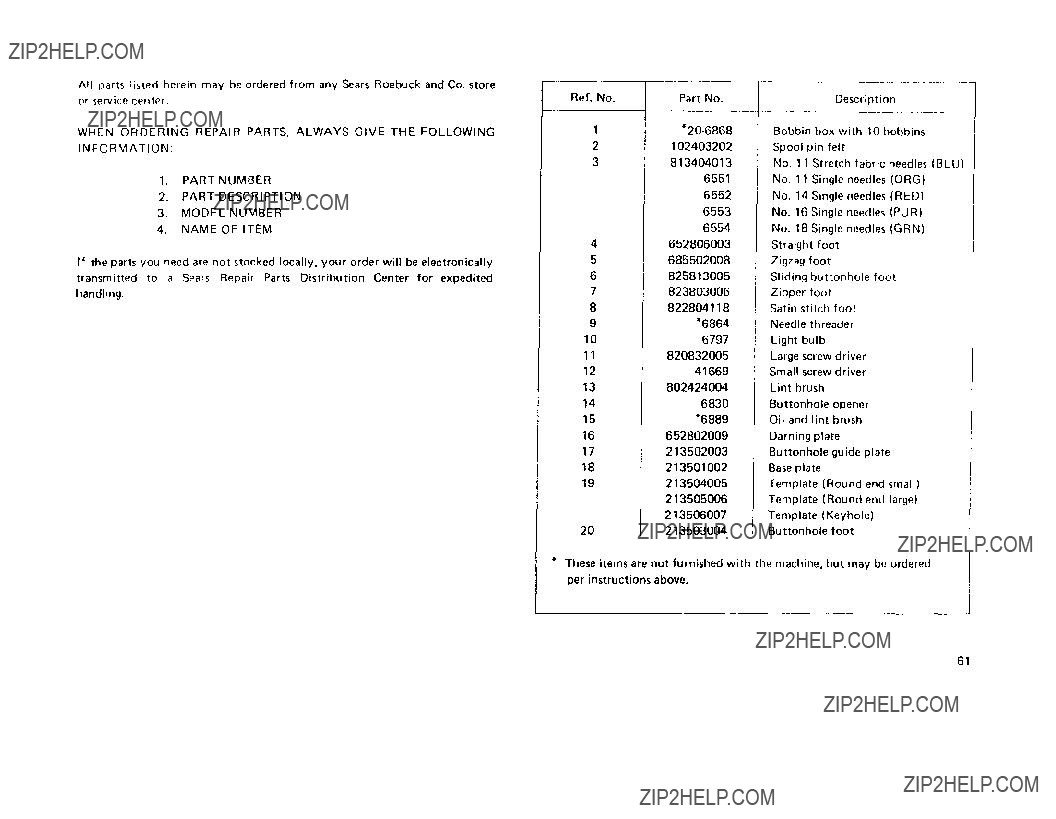
20213503004Buttonhole foot
* These items are not furnished with the machine, but may be ordered per instructions above.
61

C
INDEX
62

63
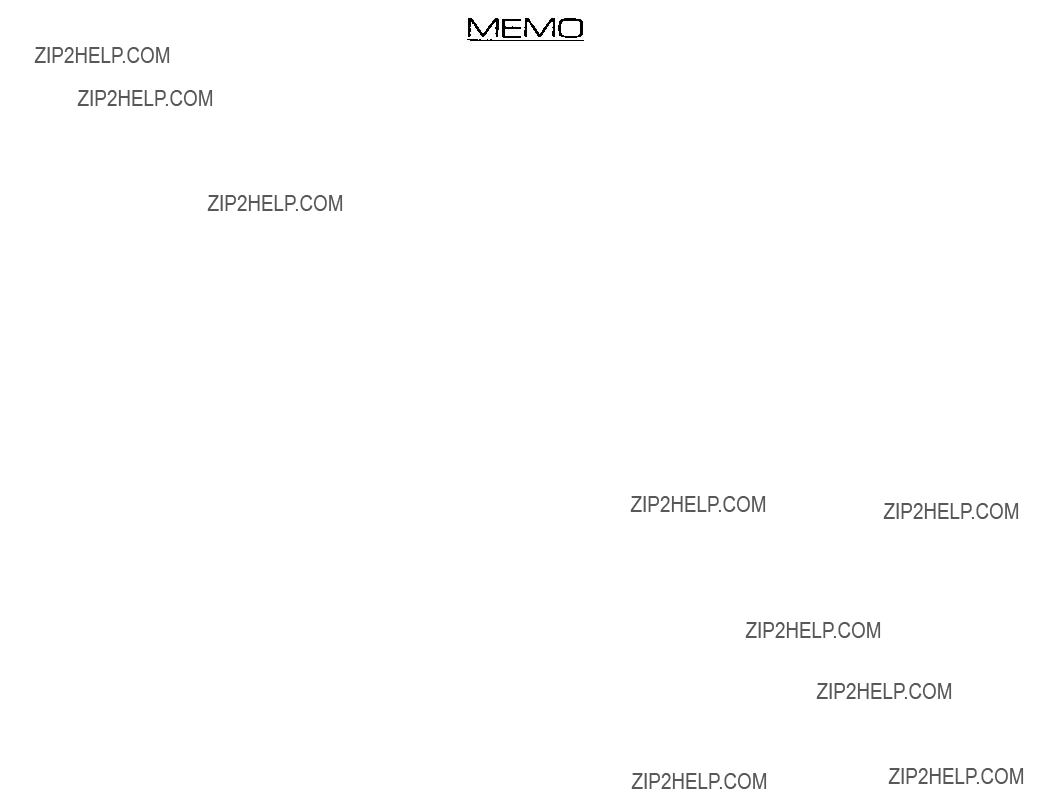
MEMO
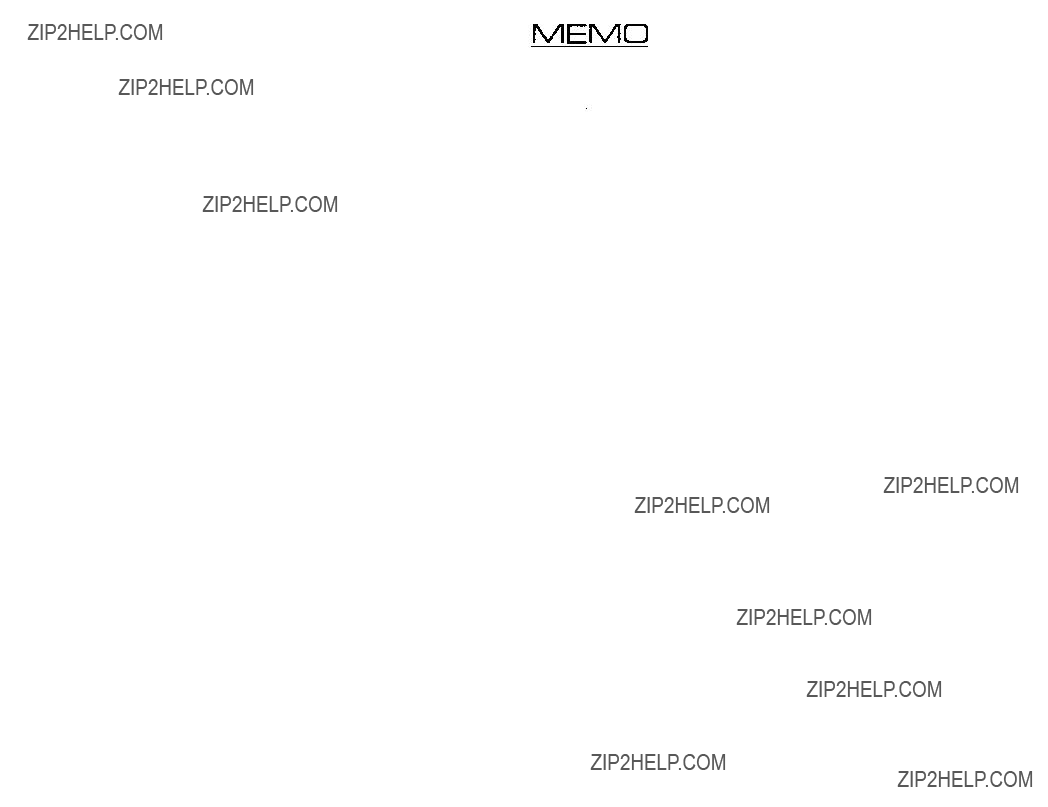
MEMO
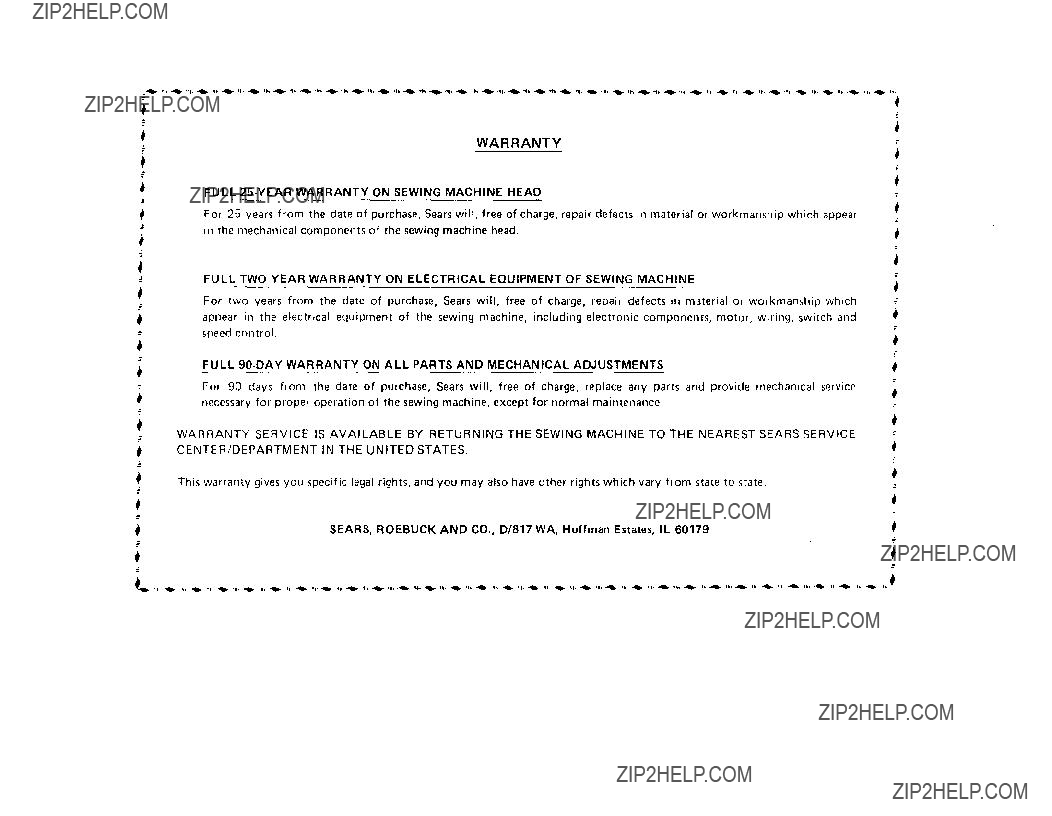
._=
=
=
=
=
WARRANTY
FULL
For 25 years from the date of purchase, Sears will, free of charge, repair defects in material or workmanship which appear m the mecha.lical components of the sewing machine head.
FULL TWO YEAR WARRANTY ON ELECTRICAL EQUIPMENT OF SEWING MACHINE
For two years from the date of purchase, Sears will, free of charge, repair defects in material or workmanship which appear in the electrical equipment of the sewing machine, including electronic components, motor, wiring, switch and speed control.
FULL
For 90 days from the date of purchase, Sears will. free of charge, replace any parts and provide mechanical service necessary for proper operation of the sewing machine, except for normal maintenance.
WARRANTY SERVICE IS AVAILABLE BY RETURNING THE SEWING MACHINE TO THE NEAREST SEARS SERVICE
CENTER/DEPARTMENT IN THE UNITED STATES.
This warranty gives you specific legal rights, and you may also have other rights which vary horn state to state.
SEARS, ROEBUCK AND CO., D/817 WA, Hoffman Estates, IL 60179
#
??
=
#
.=
#
#

SEWING MACHINE
Now that you have purchased your Kenmore Sewing Machine, should a need ever exist for repair parts or service, simply contact your nearest Sears Service Center. Be sure to provide all pertinent facts when you call or visit.
The model number of your Sewing Machine will be shown on your nomenclature plate on the back of your Sewing Machine. See page 3 for location.
WHEN ORDERING REPAIR PARTS, ALWAYS GIVE THE FOLLOWING INFORMATION:
*MODEL NUMBER *NAME OF ITEM "PART DESCRIPTION
If the parts you need are not stocked locally, your order will be electronically transmitted to a Sears Repair Parts Distribution Center for handling.
SEARS, ROEBUCK AND CO., Chicago, IL60684 U.S.A.